Search the Blog
Categories
- Books & Reading
- Broadband Buzz
- Census
- Education & Training
- General
- Grants
- Information Resources
- Library Management
- Nebraska Center for the Book
- Nebraska Libraries on the Web
- Nebraska Memories
- Now hiring @ your library
- Preservation
- Pretty Sweet Tech
- Programming
- Public Library Boards of Trustees
- Public Relations
- Talking Book & Braille Service (TBBS)
- Technology
- Uncategorized
- What's Up Doc / Govdocs
- Youth Services
Archives
Subscribe
Tag Archives: Book Covers
#BookFaceFriday “Healer & Witch” by Nancy Werlin
We’ll cast a spell on you with this #BookFaceFriday!
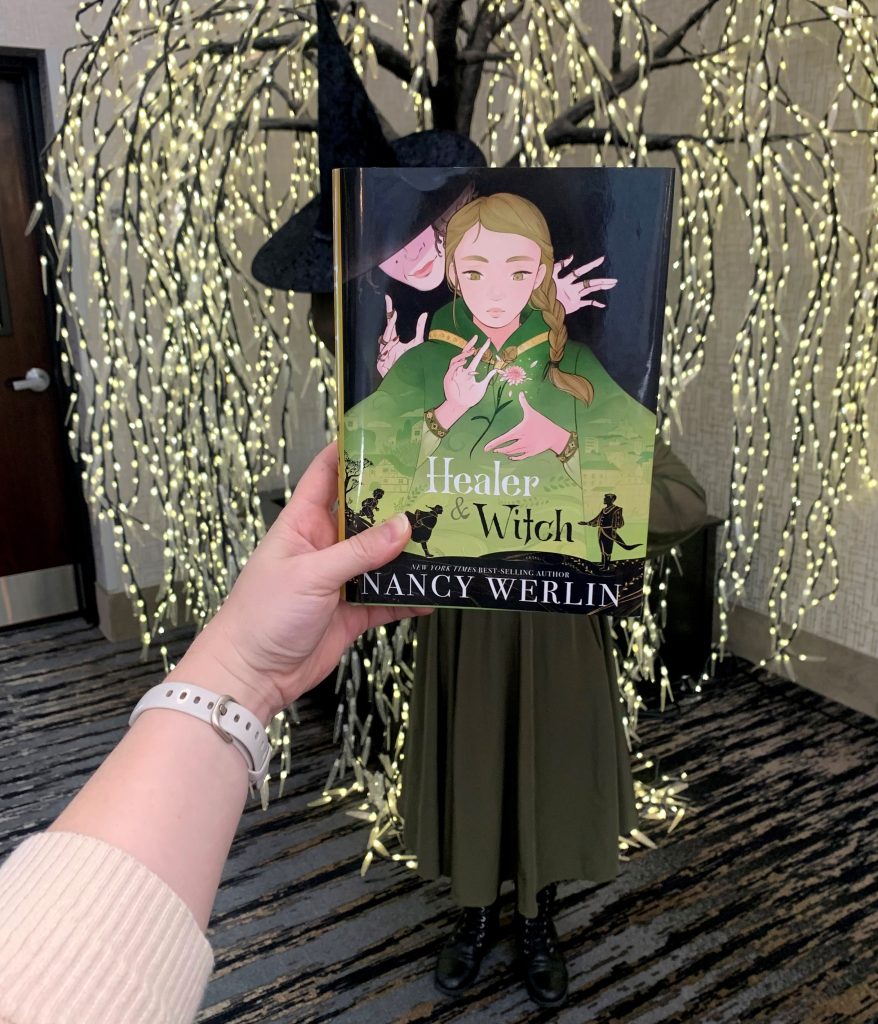
We’ve been at the Nebraska Library Association Conference this week connecting with Nebraska’s librarians and Library staff! Sally Snyder, NLC’s Children and Youth Services Coordinator, also had a table there full of her giveaway books, all available for libraries to take home with them. One of those books is this week’s #BookFace, “Healer & Witch” by Nancy Werlin (Candlewick Press, 2022). Perfect for middle grade readers, this coming-of-age YA novel is a fantasy and historical fiction story all rolled into one. All in all the perfect October read!
“Werlin’s first foray into middle grade is a thrilling and suspenseful experience; there are twisting reveals and adventure aplenty, though the story isn’t afraid to stop for lovely moments of
quiet contemplation and recollection along the way. A budding, respectful romance and hints of deeper powers will have readers hoping for a sequel. It’s well worth joining kind and clever Sylvie on her harrowing journey of discovery.”—Booklist (starred review)
This title comes from our large collection of children’s and young adult books sent to us as review copies from book publishers. When our Children and Young Adult Library Services Coordinator, Sally Snyder, is done with them, the review copies are available for the Library System Directors to distribute to school and public libraries in their systems.
Love this #BookFace & reading? Check out our past #BookFaceFriday photos on the Nebraska Library Commission’s Facebook page!
Posted in Books & Reading, General, Youth Services
Tagged Book Covers, bookface, bookfacefriday, Fantasy, Halloween, Healer & Witch, Historical Fiction, Nancy Werlin, Reading, YA books
Leave a comment
#BookFaceFriday “Unthinkable” by Helen Thomson
This #BookFace will blow your mind!

Free your mind, and the rest will follow. If you love learning through reading or just nonfiction books in general check out this week’s #BookFaceFriday, “Unthinkable” by Helen Thomson, it’s a nonfiction journey through some of the biggest mysteries of the human brain. You can find this title as an Audiobook through Nebraska OverDrive Libraries, it’s a part of the “Talk Nerdy to Me” curated collection in Overdrive.
“Thomson has a gift for making the complex and strange understandable and relatable. Oliver Sacks is noted as an inspiration and, indeed, this book will appeal to his many fans.”
—Library Journal (starred review)
Libraries participating in the Nebraska OverDrive Libraries Group currently have access to a shared and growing collection of digital downloadable audiobooks and eBooks. 194 libraries across the state share the Nebraska OverDrive collection of 26,898 audiobooks, 36,794 ebooks, and 5,133 magazines. As an added bonus it includes 130 podcasts that are always available with simultaneous use (SU), as well as SU ebooks and audiobook titles that publishers have made available for a limited time. If you’re a part of it, let your users know about this great title, and if you’re not a member yet, find more information about participating in Nebraska Overdrive Libraries
Love this #BookFace & reading? Check out our past #BookFaceFriday photos on the Nebraska Library Commission’s Facebook page!
Posted in Books & Reading, General
Tagged Book Covers, bookfacefriday, Helen Thomson, libraries, nonfiction, OverDrive, Reading, Unthinkable
Leave a comment
#BookFaceFriday “The Miseducation of Cameron Post” by Emily M. Danforth
This #BookFace is outstanding in its field!
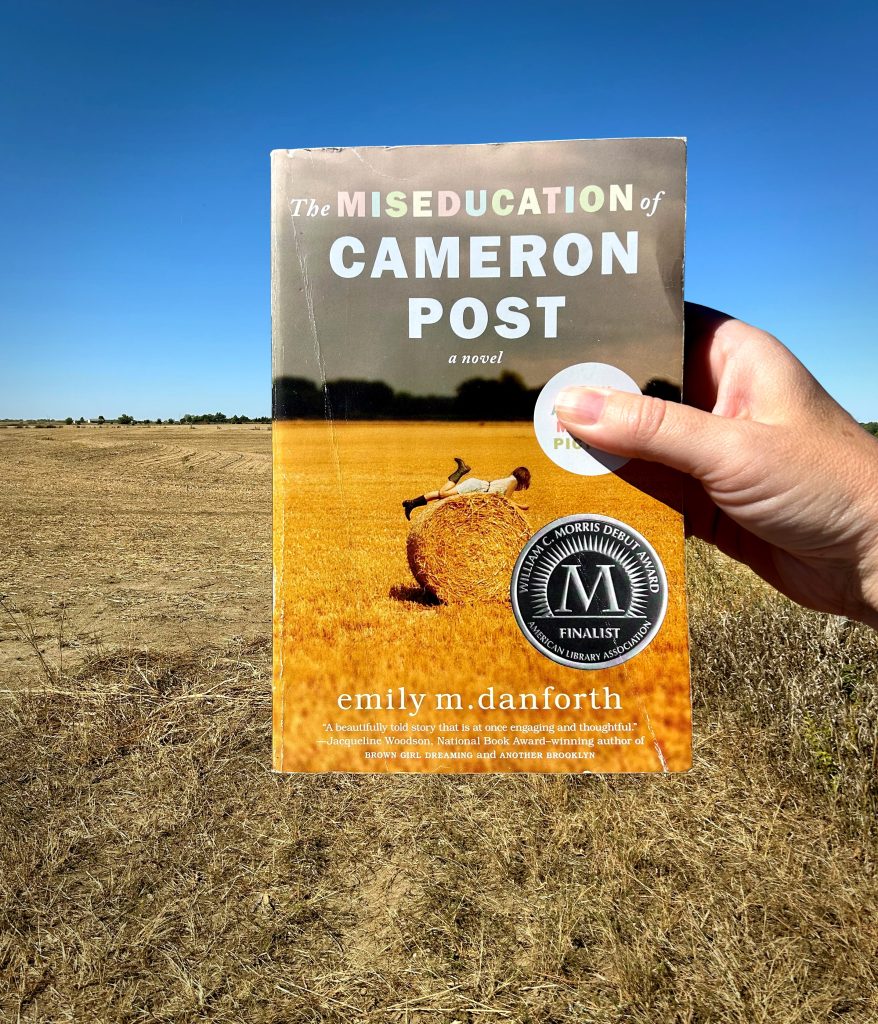
Freed between the lines! That’s the theme of this year’s #BannedBooksWeek. We are celebrating with a banned #BookFace! The Nebraska Library Commission supports readers and the freedom to read so we make sure our various collections reflect that. “The Miseducation of Cameron Post: A Novel” by Emily M. Danforth (Balzer + Bray, 2013) has been banned or challenged in the US since 2014, less than a year after it’s publication, cited for “inappropriate language, not appropriate for middle school age students.” It won The Montana Book Award and was a finalist for both the Morris Award and a Lambda Literary award. Emily Danforth was born in Montana and received her Ph.D in English-Creative Writing from the University of Nebraska-Lincoln! A book is considered challenged when calls are made for it to be banned or removed from the public’s access. This is one of many banned or challenged titles NLC has available in our Book Club Kit Collection, titles like The Perks of Being a Wallflower by Stephen Chbosky, Looking For Alaska by John Green, The Absolutely True Diary of a Part-Time Indian by Sherman Alexie, A Wrinkle in Time by Madeleine L’Engle, Beloved by Toni Morrison, and the Harry Potter Series by J.K. Rowling, just to name a few. This week’s #BookFace and other banned books can be found on the NLC Book Club Kit webpage. This service allows libraries and school librarians to “check out” multiple copies of a book without adding to their permanent collections, or budgets. NLC also has several banned or challenged titles available to our Nebraska OverDrive Libraries.
“This finely crafted, sophisticated coming-of-age debut novel is multilayered, finessing such issues as loss, first love, and friendship. An excellent read for both teens and adults.”
— School Library Journal (starred review)
You can find more information about Banned Books Week and the fight against censorship at ALA.org/advocacy/bbooks! What are you doing to celebrate Banned Books Week? Let us know!
Book Club Kits Rules for Use
- These kits can be checked out by the librarians of Nebraska libraries and media centers.
- Circulation times are flexible and will be based upon availability. There is no standard check-out time for book club kits.
- Please search the collection to select items you wish to borrow and use the REQUEST THIS KIT icon to borrow items.
- Contact the Information Desk at the Library Commission if you have any questions: by phone: 800/307-2665, or by email: Information Services Team
Love this #BookFace & reading? Check out our past #BookFaceFriday photos on the Nebraska Library Commission’s Facebook page!
Posted in Books & Reading, General
Tagged Banned Books Week, Book Club Kits, Book Covers, bookface, bookfacefriday, Lois Lowry, Reading, The Giver
Leave a comment
#BookFaceFriday “Haven’s Wake” by Ladette Randolph & “Hell or High Water” by Joy Castro
When one #BookFace closes, another one opens.
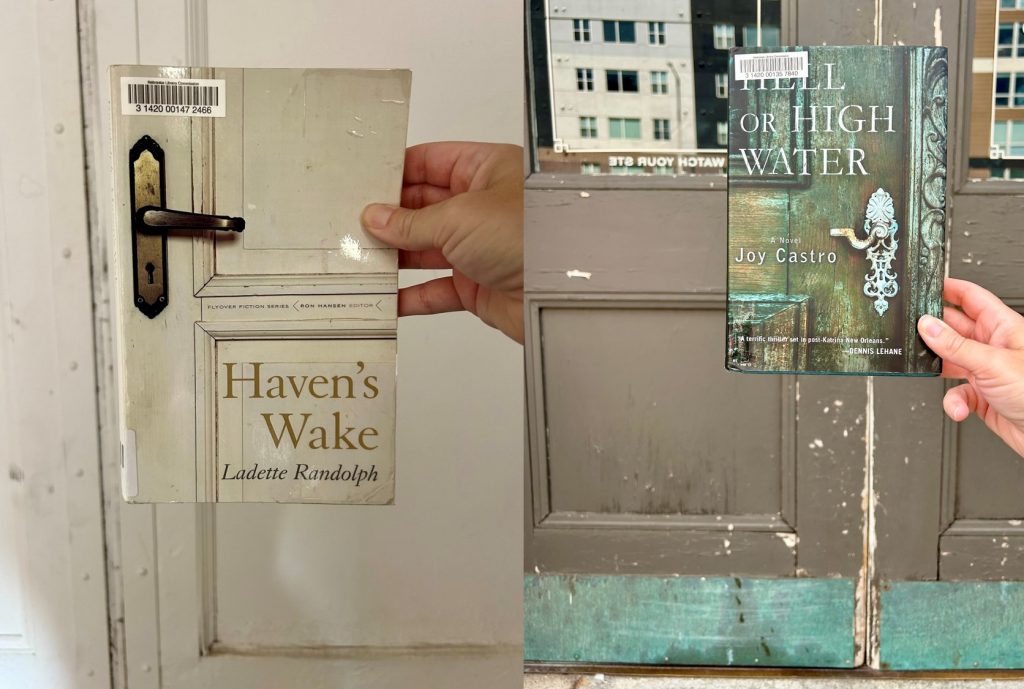
There’s nothing better than supporting Nebraska’s great literary talent by reading their books! This week’s #BookFaceFriday highlights two great Nebraska authors! “Haven’s Wake” by Ladette Randolph and “Hell or High Water” by Joy Castro, both novels are available as Book Club Kits for your library. Find more titles using the Nebraska-Related books located in the Browse Options section of our Book Club Kit Collection which includes fiction, nonfiction, adult, and kids/YA titles. Both “Haven’s Wake” and “Hell or High Water” can also be checked out through Nebraska OverDrive Libraries.
“With prose that vivifies the intricate patchwork of characters and captures the landscape’s simplicity, Haven’s Wake explores ‘the various attempts to explain the unexplainable,’ including family, faith, and death.”
—Katharine Fronk, Booklist Online
“A terrific mystery, but Hell or High Water is more than just a mystery; it’s a heartfelt examination of a second America–poor but undaunted–that was swept under the rug but refuses to stay there . . . I can’t wait to see what Joy Castro does next.”
– Dennis Lehane, New York Times bestselling author of Mystic River
Book Club Kits Rules for Use
- These kits can be checked out by the librarians of Nebraska libraries and media centers.
- Circulation times are flexible and will be based upon availability. There is no standard check-out time for book club kits.
- Please search the collection to select items you wish to borrow and use the REQUEST THIS KIT icon to borrow items.
- Contact the Information Desk at the Library Commission if you have any questions: by phone: 800/307-2665, or by email: Information Services Team
Libraries participating in the Nebraska OverDrive Libraries Group currently have access to a shared and growing collection of digital downloadable audiobooks and eBooks. 194 libraries across the state share the Nebraska OverDrive collection of 26,898 audiobooks, 36,794 ebooks, and 5,133 magazines. As an added bonus it includes 130 podcasts that are always available with simultaneous use (SU), as well as SU ebooks and audiobook titles that publishers have made available for a limited time. If you’re a part of it, let your users know about this great title, and if you’re not a member yet, find more information about participating in Nebraska Overdrive Libraries!
Love this #BookFace & reading? Check out our past #BookFaceFriday photos on the Nebraska Library Commission’s Facebook page!
#BookFaceFriday “The Underground Library” by Jennifer Ryan
Take a look, it’s in a #BookFaceFriday!

This week’s #BookFaceFriday is all about celebrating Library Card Sign Up Month! Join in with “The Underground Library: A Novel” by Jennifer Ryan (Ballantine Books, 2024). Libraries- More than Meets the Eye is this year’s theme. What can you do to help your community celebrate? Get out to your library, sign up for a library card, tell someone what you love about your library, and tell your local library staff how much you appreciate them! It’s that easy. This title is available as a an eBook and Audiobook through Nebraska OverDrive Libraries, and can be found in the specially curated collection “Library Card Sign Up Month,” which is filled with library themed titles.
“This uplifting and inspirational story is perfect for readers looking for heroic home front World War II novels with connections to actual events.”
— Historical Novel Society
Libraries participating in the Nebraska OverDrive Libraries Group currently have access to a shared and growing collection of digital downloadable audiobooks and eBooks. 194 libraries across the state share the Nebraska OverDrive collection of 26,898 audiobooks, 36,794 ebooks, and 5,133 magazines. As an added bonus it includes 130 podcasts that are always available with simultaneous use (SU), as well as SU ebooks and audiobook titles that publishers have made available for a limited time. If you’re a part of it, let your users know about this great title, and if you’re not a member yet, find more information about participating in Nebraska Overdrive Libraries!
Love this #BookFace & reading? We suggest checking out all the titles available for book clubs at http://nlc.nebraska.gov/ref/bookclub. Check out our past #BookFaceFriday photos on the Nebraska Library Commission’s Facebook page!
#BookFaceFriday – “On the Go with Senior Services” by Phyllis Goodman
Listen up, it’s #BookFaceFriday!

The Nebraska Library Commission is hiring! We are looking for a Marketing and Outreach Coordinator for our Talking Book and Braille (TBBS) department to help us recruit, retain, and engage our TBBS patrons.
The Talking Book and Braille Service is a no-cost braille and Audiobook library service for people with temporary or permanent low vision, blindness, or a physical or perceptual disability that prevents them from reading or holding the printed page or a reading disability. It’s one of the NLC’s core services and, while not limited to, is used by many Nebraska senior citizens.“On the Go with Senior Services : Library Programs for Any Time and Any Place” by Phyllis Goodman (Libraries Unlimited, 2020) is a part of NLC’s Library Science Collection, which provides professional and reference materials for Nebraska librarians and library science programs. This includes all librarians and library science students. The checkout period is 4 weeks, and items can be sent through the mail or picked up in person. You can find all of these books and more in our catalog, or reach out to our reference staff for a recommendation!
“Providing programming at senior living facilities may be uncharted territory for many libraries. If you’re looking to begin offering programs for senior residents, start your research with this book. Find inspiration to take seniors to the past or around the world, make everyone an artist or author, empower them to use technology confidently, and connect with people living with dementia.”
― Jennie Fidler, Special Services Coordinator, Oconomowoc Public Library
Love this #BookFace & reading? Check out our past #BookFaceFriday photos on the Nebraska Library Commission’s Facebook page!
Posted in Books & Reading, Education & Training, Library Management, Talking Book & Braille Service (TBBS)
Tagged Book Covers, bookface, bookfacefriday, books, Hiring, Librarians, Library Development, Library Science, Marketing Outreach Coordinator, On the Go with senior Services, Phyllis Goodman, TBBS
Leave a comment
Friday Reads : Flight Patterns, by Karen White
I recently picked up Flight Patterns, by Karen White, at a library book sale. And while the author was new to me, what really drew my attention was not just the description of the story, but of the story’s location: Apalachicola, Florida. Apalach, as it’s known to it’s residents, is a town not far from where I grew up and that offers some of the most beautiful homes, gorgeous beaches, and best seafood in the entire South. Flight Patterns tells the story of a woman coming home to the Apalach family she left behind – and to the woman she always wanted to be. In the telling of this woman’s story, Ms. White has done such a magnificent job of describing the beauty of the town, area and people, that it brought back many fond memories of summer days there with my family. As per my usual habit, I both read and listened to this title, and was riveted from beginning to end, as I’m sure you will be too!
Georgia Chambers has spent her life sifting through other people’s pasts while trying to forget her own. But then her work as an expert on fine china – especially Limoges and the mystery surrounding a particular pattern – requires her to return to the one place she swore she’d never revisit: her home town.
It’s been 13 years since Georgia left her family home on the coast of Florida, and nothing much has changed except that there are fewer oysters and more tourists. She finds solace in seeing her grandfather still toiling away with his bees in the apiary where she spent much of her childhood, but encountering her estranged mother and sister leaves her rattled. Seeing them after all this time makes Georgia realize that something has been missing – and unless she finds a way to heal these rifts, she will forever be living vicariously through other people’s remnants. To embrace her own life – mistakes and all – she will have to find the courage to confront the ghosts of her past and the secrets she was forced to keep. **Synopsis courtesy of Audible
#BookFaceFriday “The Book of Unknown Americans” by Cristina Henríquez
Did you know it’s #BookFaceFriday?
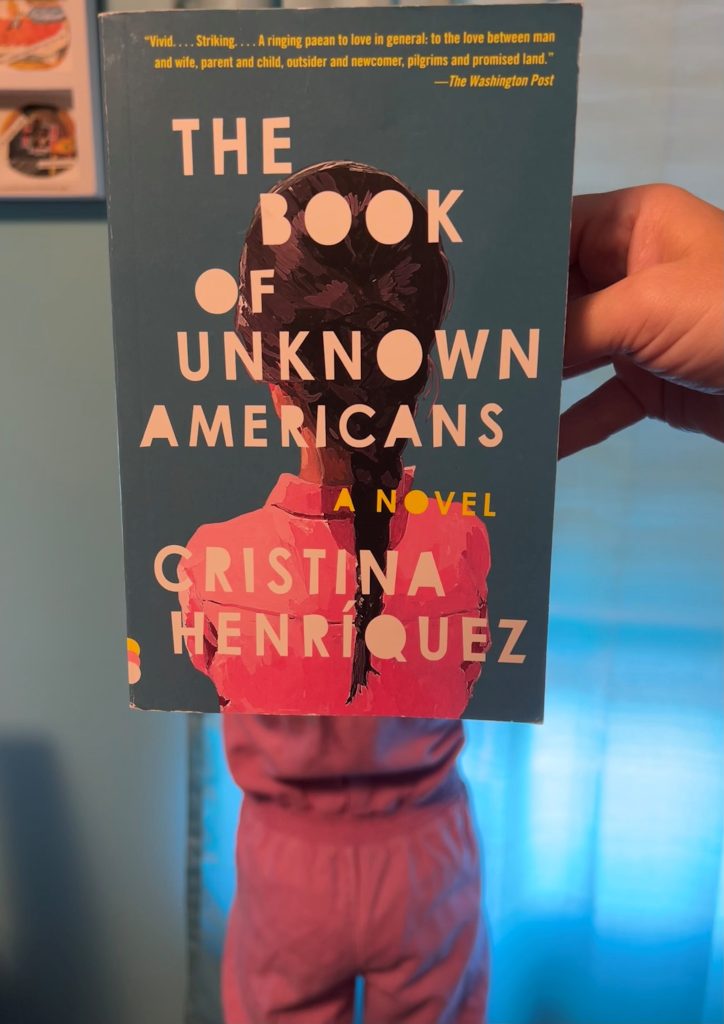
Don’t blame us for judging a book by its cover – this one was just asking to become this week’s #BookFace! But sometimes those first impressions prove to be correct; “The Book of Unknown Americans” by Cristina Henríquez, was “named a New York Times and Washington Post Notable Book, an NPR Great Read, The Daily Beast’s Novel of the Year, and a Mother Jones, Oprah.com, School Library Journal, and BookPage Best Book of the Year.” This title is available as a part of our Book Club Kit collection, and also as an eBook and Audiobook through Nebraska OverDrive Libraries. Will your book club enjoy it? Only one way to know for sure…
“There’s an aura of benevolence in these pages…. Henríquez’s feat is to make the reader feel at home amid these good, likable people.”
—The Wall Street Journal
“Unfailingly well written and entertaining…. [Henríquez’s] stories illuminate the lives behind the current debates about Latino immigration.”
– The New York Times Book Review
Book Club Kits Rules for Use
- These kits can be checked out by the librarians of Nebraska libraries and media centers.
- Circulation times are flexible and will be based upon availability. There is no standard check-out time for book club kits.
- Please search the collection to select items you wish to borrow and use the REQUEST THIS KIT icon to borrow items.
- Contact the Information Desk at the Library Commission if you have any questions: by phone: 800/307-2665, or by email: Information Services Team
Libraries participating in the Nebraska OverDrive Libraries Group currently have access to a shared and growing collection of digital downloadable audiobooks and eBooks. 194 libraries across the state share the Nebraska OverDrive collection of 26,898 audiobooks, 36,794 ebooks, and 5,133 magazines. As an added bonus it includes 130 podcasts that are always available with simultaneous use (SU), as well as SU ebooks and audiobook titles that publishers have made available for a limited time. If you’re a part of it, let your users know about this great title, and if you’re not a member yet, find more information about participating in Nebraska Overdrive Libraries!
Love this #BookFace & reading? Check out our past #BookFaceFriday photos on the Nebraska Library Commission’s Facebook page!
#BookFaceFriday “The White House: A Meet the Nation’s Capital Book” by Lindsay Ward
This #BookFaceFriday is in Washington D.C.!

There’s so much to learn in this week’s #BookFace! “The White House: A Meet the Nation’s Capital Book” by Lindsay Ward (HarperCollins, August 2024) is a fun, interactive picture book that’s perfect for educating kids on the inner workings and different people who work inside of the White House.
“An expansive reminder that our government is of, as well as by and for, the people.” —Kirkus Reviews
We couldn’t resist bringing this week’s bookface with us to the National Book Festival in Washington, D.C.! The Nebraska Center for the Book has selected one youth book and one adult book by Nebraska authors to represent the state at the 2024 National Book Festival: “Eat Your Woolly Mammoths!: Two Million Years of the World’s Most Amazing Food Facts, from the Stone Age to the Future” by James Solheim and “Dancing with the Octopus: A Memoir of a Crime” by Debora Harding. Both titles will be part of the National Center for the Book’s Great Reads from Great Places program. Check out the festival schedule, featured authors, and highlights for past events on the Library of Congress’s event page!
This title comes from our large collection of children’s and young adult books sent to us as review copies from book publishers. When our Children and Young Adult Library Services Coordinator, Sally Snyder, is done with them, the review copies are available for the Library System Directors to distribute to school and public libraries in their systems.
Love this #BookFace & reading? Check out our past #BookFaceFriday photos on the Nebraska Library Commission’s Facebook page!
#BookFaceFriday “Murder on a School Night” by Kate Weston
We did our homework- it’s #BookFaceFriday!
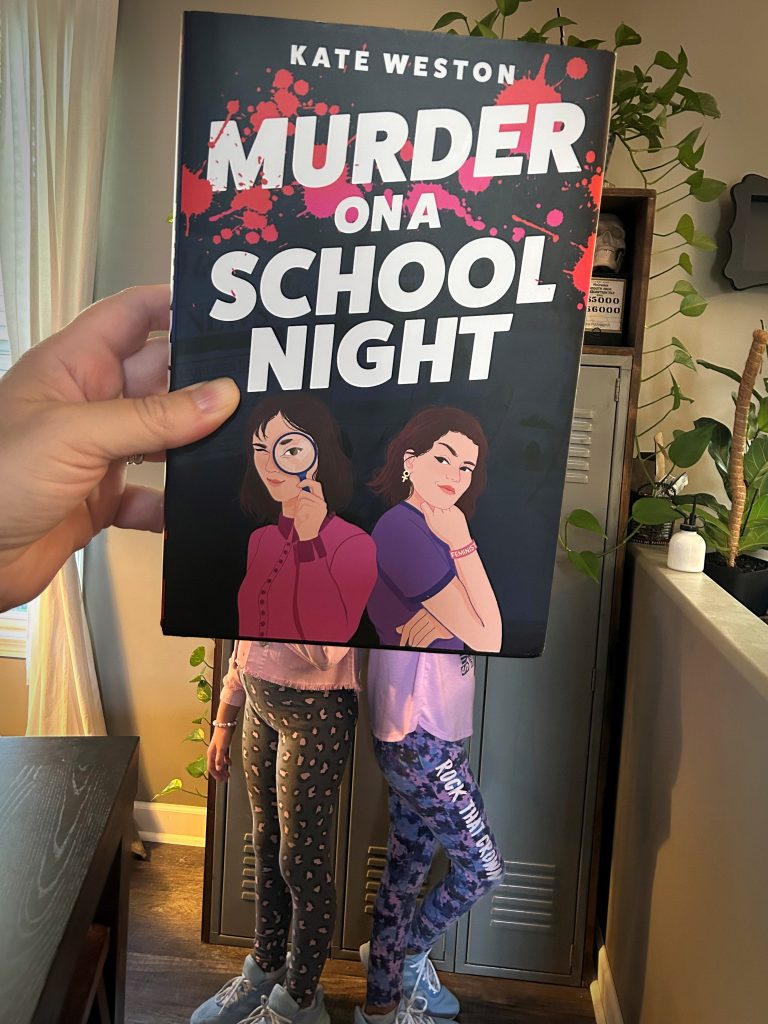
Don’t let the first few week’s of school push you over the edge! Back to school can be stressful, but finding great books for your kids to read doesn’t have to be. Whether its through our Book Club Kits collection, eBooks and Audiobooks in Nebraska OverDrive Library, picking up a title from our giveaway books. there is something for everyone in at all reading levels. Like this week’s #BookFace! “Murder on a School Night” by Kate Weston (Katherine Tegen Books, 2023) this funny, witty murder mystery for teens is written by a former stand up comedian and bookseller.
“Mean Girls meets Midsomer Murders with a dash of Louise Rennison in this genre-blending story that centers girls’ friendships and two ambitious best friends. Kerry and Annie are self-absorbed friends whose obsession over their lack of popularity results in hysterically funny dialogue and a lighthearted tone. Kerry’s crush on newcomer Scott offers sweet diversions. However, what really elevates the goofy capers and over-the-top scheming is how well Kerry and Annie know both themselves and each other. Secrets add depth and complexity to this insightful parody of teenage life. A nuanced, hilarious page-turning romantic mystery.” —Kirkus Reviews
This title comes from our large collection of children’s and young adult books sent to us as review copies from book publishers. When our Children and Young Adult Library Services Coordinator, Sally Snyder, is done with them, the review copies are available for the Library System Directors to distribute to school and public libraries in their systems.
Love this #BookFace & reading? Check out our past #BookFaceFriday photos on the Nebraska Library Commission’s Facebook page!
Posted in Books & Reading, General, Youth Services
Tagged back to school, Book Covers, bookface, bookfacefriday, Kate Weston, Murder on a School Night, Reading
Leave a comment
#BookFaceFriday “Proud” by Ibtihaj Muhammad
En guard! It’s #BookFaceFriday!

On the fence about what to read this weekend? Why not check out one of the many titles about the Olympic Games and athletes available on Overdrive. This week’s #BookFace, “Proud: My Fight for an Unlikely American Dream” by Ibtihaj Muhammad with Lori Tharps, is the memoir of Olympic bronze medalist and Muslim American, Ibtihaj Muhammad. You can find this title as an Audiobook through Nebraska OverDrive Libraries, as well as her Young Readers Edition “Proud: Living My American Dream” which is available as both an eBook and Audiobook.
“Fencing made her who she is today, but fencing isn’t her only narrative. Her journey is one of authenticity at all costs and being unapologetically herself.”
—ESPNw
Libraries participating in the Nebraska OverDrive Libraries Group currently have access to a shared and growing collection of digital downloadable audiobooks and eBooks. 194 libraries across the state share the Nebraska OverDrive collection of 26,898 audiobooks, 36,794 ebooks, and 5,133 magazines. As an added bonus it includes 130 podcasts that are always available with simultaneous use (SU), as well as SU ebooks and audiobook titles that publishers have made available for a limited time. If you’re a part of it, let your users know about this great title, and if you’re not a member yet, find more information about participating in Nebraska Overdrive Libraries
Love this #BookFace & reading? Check out our past #BookFaceFriday photos on the Nebraska Library Commission’s Facebook page!
#BookFaceFriday “Storm Cursed” by Patricia Briggs
Brace yourself, it’s #BookFaceFriday!
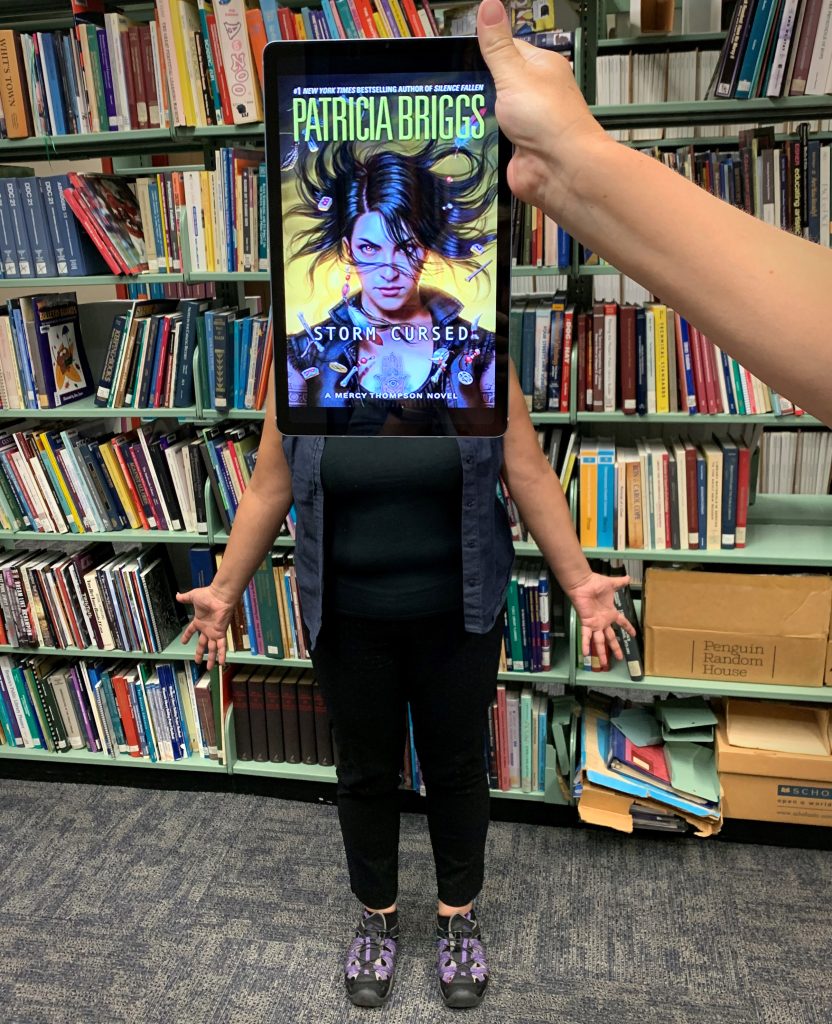
There’s nothing like reading by candlelight, or maybe in this case, by the light of your e-reader. Batten the hatches during the next Nebraska storm with a good book. This week’s #BookFace would be an excellent book to escape into; “Storm Cursed” by Patricia Briggs, is book eleven in Brigg’s Mercy Thompson series. This supernatural shapeshifter series combines adventure, wit, and magic. It’s available as both an eBook and audiobook in Nebraska OverDrive Libraries, along with fourteen other books in the Mercy Thompson series.
“This story brings together a lot of seemingly unrelated plot threads from past novels in a way that feels organic and that doesn’t impede the pacing of the current mystery. Fans of the series will enjoy this solid addition, but new readers might find that there’s too much history to make this story work as an ingress point.” —Publishers Weekly
“Patricia Briggs never fails to deliver an exciting, magic and fable filled suspense story.” – Erin Watt, #1 New York Times bestselling author of The Royals series
This week’s model is one of the newer additions to the Nebraska Library Commission. Welcome, Veronica Powell, as our new Cataloging Librarian!
This title is also available as an audiobook through Nebraska OverDrive Libraries. Libraries participating in the Nebraska OverDrive Libraries Group currently have access to a shared and growing collection of digital downloadable audiobooks and eBooks. 194 libraries across the state share the Nebraska OverDrive collection of 26,898 audiobooks, 36,794 ebooks, and 5,133 magazines. As an added bonus it includes 130 podcasts that are always available with simultaneous use (SU), as well as SU ebooks and audiobook titles that publishers have made available for a limited time. If you’re a part of it, let your users know about this great title, and if you’re not a member yet, find more information about participating in Nebraska Overdrive Libraries!
Love this #BookFace & reading? Check out our past #BookFaceFriday photos on the Nebraska Library Commission’s Facebook page!
#BookFaceFriday “The Boys in the Boat” by Daniel James Brown
This #BookFaceFriday is going for the gold!
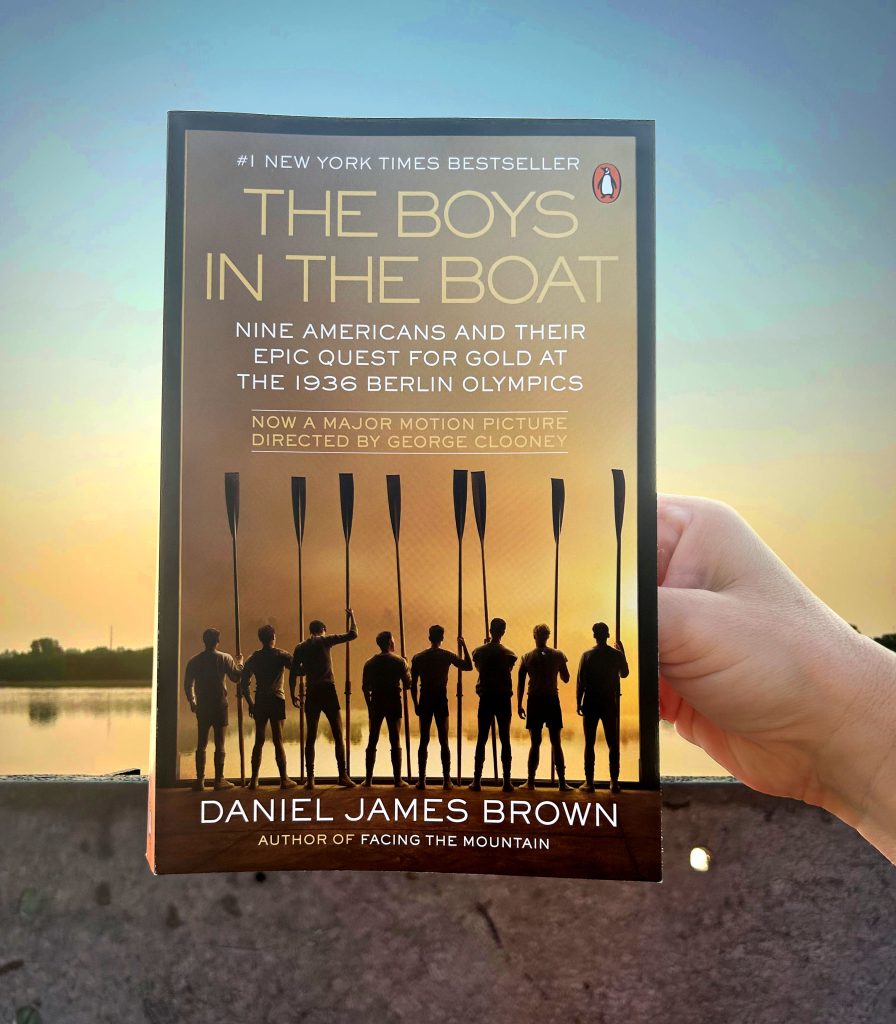
As Olympic hopefuls flock to Paris for this year’s games, take a trip back in time to the 1936 Berlin Olympics. This week’s #BookFace, “The Boys in the Boat: Nine Americans and Their Epic Quest for Gold at the 1936 Berlin Olympics” by Daniel James Brown, is a #1 New York Times–bestselling story. This epic story of Olympic hopefuls is available as a part of our Book Club Kit collection. This title is also available as an eBook and Audiobook through Nebraska OverDrive Libraries.
“For those who like adventure stories straight-up, THE BOYS IN THE BOAT… is this year’s closest approximation of Unbroken…. It’s about the University of Washington’s crew team: “Nine working-class boys from the American West who at the 1936 Olympics showed the world what true grit really meant.”
—New York Times
Book Club Kits Rules for Use
- These kits can be checked out by the librarians of Nebraska libraries and media centers.
- Circulation times are flexible and will be based upon availability. There is no standard check-out time for book club kits.
- Please search the collection to select items you wish to borrow and use the REQUEST THIS KIT icon to borrow items.
- Contact the Information Desk at the Library Commission if you have any questions: by phone: 800/307-2665, or by email: Information Services Team
Libraries participating in the Nebraska OverDrive Libraries Group currently have access to a shared and growing collection of digital downloadable audiobooks and eBooks. 194 libraries across the state share the Nebraska OverDrive collection of 26,898 audiobooks, 36,794 ebooks, and 5,133 magazines. As an added bonus it includes 130 podcasts that are always available with simultaneous use (SU), as well as SU ebooks and audiobook titles that publishers have made available for a limited time. If you’re a part of it, let your users know about this great title, and if you’re not a member yet, find more information about participating in Nebraska Overdrive Libraries!
Love this #BookFace & reading? Check out our past #BookFaceFriday photos on the Nebraska Library Commission’s Facebook page!
Posted in Books & Reading, General
Tagged book club kit, Book Covers, bookfacefriday, Daniel James Brown, libraries, Olympics, OverDrive, Reading, The Boys in the Boat
Leave a comment
#BookFaceFriday “Creative Genius: The Art of the Nebraska Capitol”
Life imitates art with #BookFaceFriday!
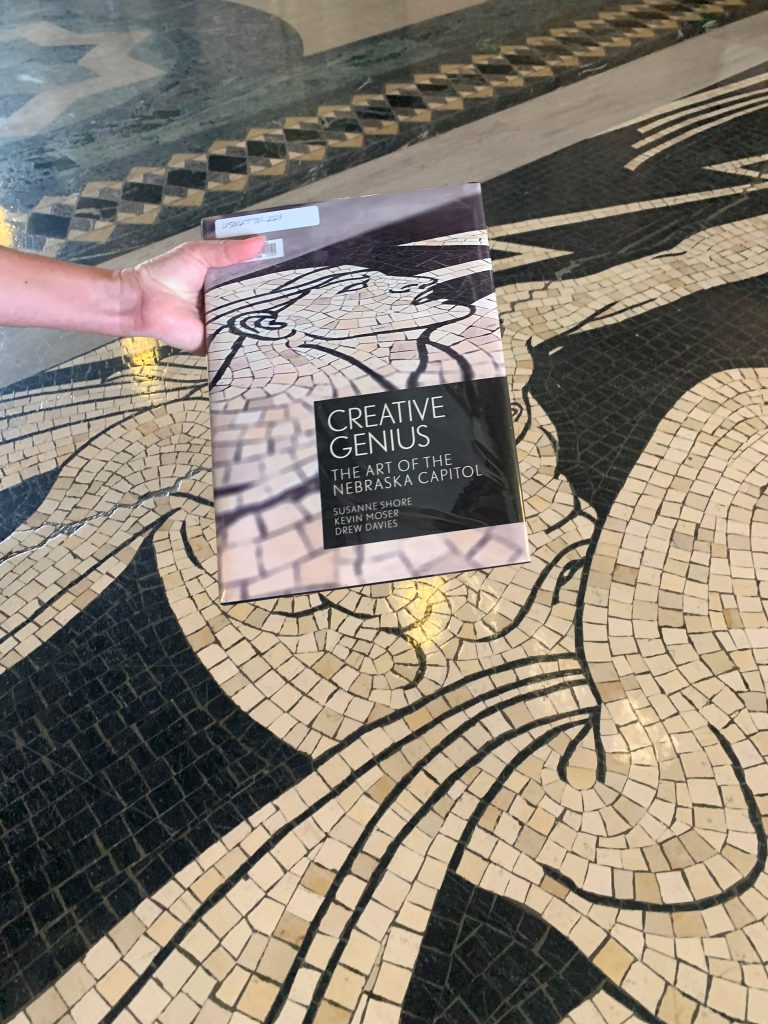
The surprisingly complex task of photographing the surprisingly complex photography of this #BookFaceFriday was a challenge. While nothing can compare to seeing it in person, this week’s #BookFace is an excellent way to bring a little of the Nebraska Capitol’s beauty and history into your own home. “Creative Genius: The Art of the Nebraska Capitol” by by Susanne Shore, Kevin Moser, Drew Davies, with a foreword by Robert C. Ripley, is available as a part of our Nebraska State Documents Collection.
One of the most prestigious academic presses in the country, the University of Nebraska Press sends us around 75 select titles per year, which are added to the Nebraska Publications Clearinghouse, also known as the Nebraska State Documents Collection. This collection is comprised of publications issued by Nebraska state agencies, ensuring that state government information is available to a wide audience and that those valuable publications are preserved for future generations. University of Nebraska Press books, as well as all state documents, are available for checkout by libraries and librarians for their patrons.
“The Nebraska State Capitol may be the most beautiful capitol building in the United States. From the day it opened, it’s been recognized as an outlier relative to its forty-nine rivals. The influential leaders of American Architect certainly thought so, choosing to feature the Nebraska Capitol in the October 1934 issue soon after the building opened. In the introduction, they wrote: ‘From the engineering standpoint, the building embodies the cumulative results of American energy, inventive skill and organizing ability; and from all combined points of view, it stands as a remarkable interpretation of innumerable events that have shaped the progress of American art, industry, and democratic government.’”
—from the prologue
Love this #BookFace & reading? Check out our past #BookFaceFriday photos on the Nebraska Library Commission’s Facebook page!
#BookFaceFriday “Year of Wonders” by Geraldine Brooks
Don’t hold your breath for this #BookFaceFriday!
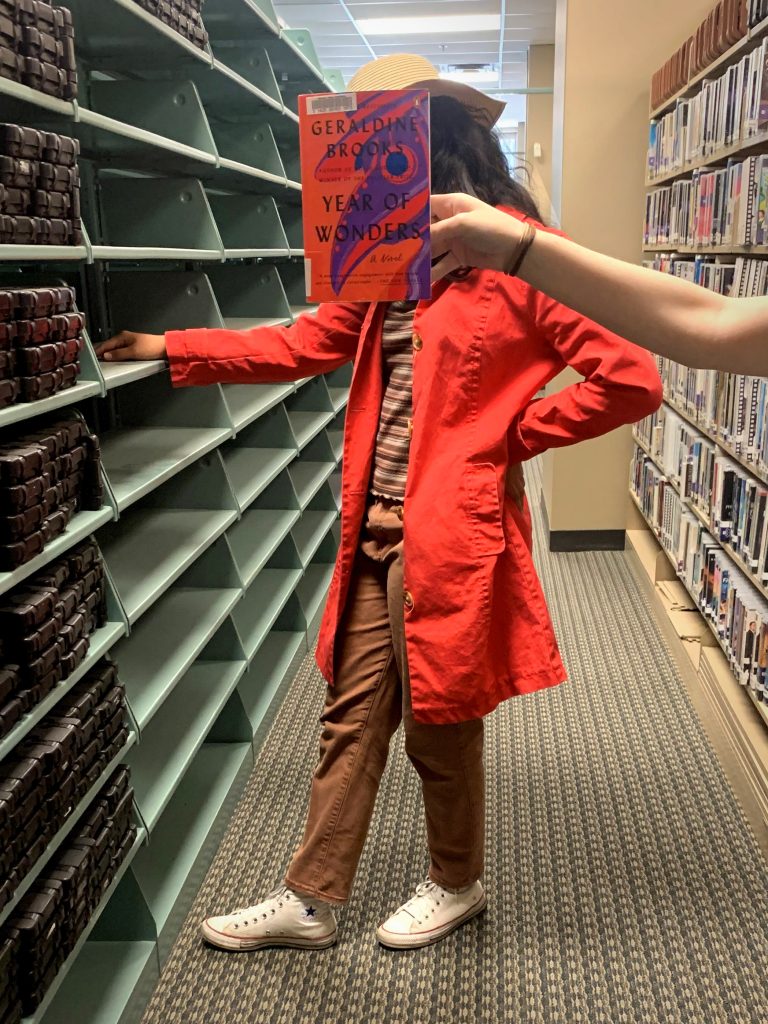
“Bring out your dead! Bring out your dead!” This week’s #BookFace isn’t exactly a Monty Python comedy but it is all about the plague in 1666 in a small village in England. “Year of Wonders: A Novel” by Pulitzer Prize winning author Geraldine Brooks, is a beautifully written novel, available as a part of our Book Club Kit collection along with three other books written by Geraldine Brooks.
“Plague stories remind us that we cannot manage without community . . . Year of Wonders is a testament to that very notion . . . [The villagers] assume collective responsibility for combating the plague, rather than seeing it as an act of God before which they are powerless.”
—Washington Post
This week’s model is the newest addition to the Talking Book and Braille Services. Welcome, Liz Macias, as TBBS’s Studio and Book Circulation Support. Liz comes to us from Kearney with a broadcasting background. Her favorite reads are mystery fantasy graphic novels, and currently reading “The Sandman” by Neil Gaiman. When her eyes are not on a graphic novel, it’s either on her latest crocheting project, plants, or catching up on shows. If you see Liz make sure to say hello!
Book Club Kits Rules for Use
- These kits can be checked out by the librarians of Nebraska libraries and media centers.
- Circulation times are flexible and will be based upon availability. There is no standard check-out time for book club kits.
- Please search the collection to select items you wish to borrow and use the REQUEST THIS KIT icon to borrow items.
- Contact the Information Desk at the Library Commission if you have any questions: by phone: 800/307-2665, or by email: Information Services Team
This title is also available as an Audiobook through Nebraska OverDrive Libraries. You can find six books by Geraldine Brooks in our OverDrive Libraries collections! Libraries participating in the Nebraska OverDrive Libraries Group currently have access to a shared and growing collection of digital downloadable audiobooks and eBooks. 194 libraries across the state share the Nebraska OverDrive collection of 26,898 audiobooks, 36,794 ebooks, and 5,133 magazines. As an added bonus it includes 130 podcasts that are always available with simultaneous use (SU), as well as SU ebooks and audiobook titles that publishers have made available for a limited time. If you’re a part of it, let your users know about this great title, and if you’re not a member yet, find more information about participating in Nebraska Overdrive Libraries!
Love this #BookFace & reading? Check out our past #BookFaceFriday photos on the Nebraska Library Commission’s Facebook page!
Book Briefs: New University of Nebraska Press Books at the Nebraska Publications Clearinghouse
Apologies that this installment of Book Briefs has taken so long–we have been without a cataloger since December 1st, 2023, but our new cataloger starts July 15th!
The Nebraska Publications Clearinghouse receives documents every month from all Nebraska state agencies, including the University of Nebraska Press (UNP). We normally post every two months, but today we are catching up with our backlog of the UNP books that the Clearinghouse has received.
UNP books, as well as all Nebraska state documents, are available for checkout by libraries and librarians for their patrons.
Here are the UNP books the Clearinghouse received in January through June, 2024:
Antilla, by Henrietta Goodman. Series: The Backwaters Prize in Poetry Honorable Mention
The title poem of this collection refers to the phantom island of Antillia, included on maps in the fifteenth century but later found not to exist. The ghosts that haunt this collection are phantom islands, moon lakes, lasers used to clean the caryatids at the Acropolis, earlier versions of the self, suicides, a madam from the Old West, petroleum, snapdragons, pets, ice apples, Casper, and a “resident ghost” who makes the domestic realm of “the cradle and the bed” uninhabitable. The ghosts are sons, fathers “asleep in front of the TV,” and a variety of exes—“lost boys” with names like The Texan and Mr. No More Cowboy Hat whom Henrietta Goodman treats with snarky wit but also with grief, guilt, and love.
Although memories pervade this collection, these poems also look forward and outward into a world where social inequality and environmental disaster meet the possibility of metamorphosis.
Boundless Deep, and Other Stories, by Gen Del Raye. Series: The Raz/Shumaker Prairie Schooner Book Prize in Fiction
Winner of the Raz/Shumaker Prairie Schooner Book Prize in Fiction, Boundless Deep, and Other Stories is a portrait of a family that holds together despite everything. By turns introspective, surreal, and bitingly funny, this collection of linked short stories spans seven decades across Japan and the United States and shows the tenacity of relationships fractured by language and distance.
At the funeral of her old boss, a grandmother confronts the legacy of the draft letters she delivered as a girl during World War II. Facing the loss of his job, a father becomes the caricature strangers have always believed him to be. A graduate student living far from home is worn down by the reality of what it takes to save even a small piece of the world. Along the way, we meet communist revolutionary Shigenobu Fusako hiding out in a Tokyo hotel, submariner and war criminal Nishina Sekio in his tortured dreams, and Edwin, a half-dolphin friend, wreaking havoc in a public pool. Written in the compressed style of Amy Hempel and Lucia Berlin, these stories examine characters whose struggles submerge them, weighing them down from every angle, until they can finally float free.
Brand Antarctica : How Global Consumer Culture Shapes Our Perceptions of the Ice Continent, by Hanne Elliot Fonss Nielsen. Series: Polar Studies
Antarctica is, and has always been, very much “for sale.” Whales, seals, and ice have all been marketed as valuable commodities, but so have the stories of explorers. The modern media industry developed in parallel with land-based Antarctic exploration, and early expedition leaders needed publicity to generate support for their endeavors. Their lectures, narratives, photographs, and films were essentially advertisements for their adventures. At the same time, popular media began to use the newly encountered continent to draw attention to commercial products. These advertisements both trace the commercialization of Antarctica and reveal how commercial settings have shaped the dominant imaginaries of the place.
By contextualizing and analyzing Antarctic advertisements from the late nineteenth century to the present, Brand Antarctica identifies five key framings of the South Polar continent: a place for heroes, a place of extremity, a place of purity, a place to protect, and a place that transforms. Demonstrating how these conceptual framings of Antarctica in turn circulate through our culture, Hanne Elliot Fønss Nielsen challenges common assumptions about Antarctica’s past and present, encouraging readers to rethink their own relationship with the Far South.
Bribed With Our Own Money : Federal Abuse of American Indian Funds in the Termination Era, by David R. M. Beck. Series: New Visions in Native American and Indigenous Studies
In Bribed with Our Own Money David R. M. Beck analyzes the successes and failures of Indigenous nations’ opposition to federal policy in the 1950s and 1960s. Focusing on case studies from six Native nations, Beck recounts how the U.S. government coerced American Indian nations to accept termination of their political relationship with the United States by threatening to withhold money that belonged to the tribes.
Termination was the continuation—and, federal officials hoped, the culmination—of more than a century of policy initiatives intended to end the political relationship between Indian tribal nations and the federal government. Termination was also intended to assimilate American Indian individuals into the country’s social and economic culture and to remove the remainder of reservation lands from federal trust. American Indians hoped to gain greater opportunities of self-governance and self-determination, but they wanted to do so under the protection of the federal trust relationship.
Bribed with Our Own Money analyzes both successful and unsuccessful efforts of Native nations to oppose this policy within the larger context of long-standing federal abuse of tribal funds. It is the first book to view federal termination efforts grounded in bribery for what they were: a form of coercion.
Buffalo Bill and the Mormans, by Brent M. Rogers.
In this never-before-told history of Buffalo Bill and the Mormons, Brent M. Rogers presents the intersections in the epic histories of William F. “Buffalo Bill” Cody and the Latter-day Saints from 1846 through 1917. In Cody’s autobiography he claimed to have been a member of the U.S. Army wagon train that was burned by the Saints during the Utah War of 1857–58. Less than twenty years later he began his stage career and gained notoriety by performing anti-Mormon dramas. By early 1900 he actively recruited Latter-day Saints to help build infrastructure and encourage growth in the region surrounding his town of Cody, Wyoming.
In Buffalo Bill and the Mormons Rogers unravels this history and the fascinating trajectory that took America’s most famous celebrity from foe to friend of the Latter-day Saints. In doing so, the book demonstrates how the evolving relationship between Cody and the Latter-day Saints can help readers better understand the political and cultural perceptions of Mormons and the American West.
Creative Genius : The Art of the Nebraska Capitol, by Susanne Shore, Kevin Moser, and Drew Davies.
Few buildings reveal truths, inspire greatness, and narrate the creation of humanity. Creative Genius: The Art of the Nebraska Capitol documents such a place. The Nebraska Capitol—once called “a peak in the history of building accomplishment”—breaks the boundaries of architecture and art.
Creative Genius unveils new images of the art of the Capitol in striking detail. Included are some of the greatest works by some of America’s most recognized artists and visionaries.
Along with remarkable visuals, Creative Genius delivers insights into the extraordinary stories and vision behind the art. Steeped in history and lore, the building narrates the creation of the universe and life, as well as the epic journey of the peoples of Nebraska. This book reveals the themes driving the art, chronicles the stories behind artists and their creations, and celebrates the beauty embodied in this influential building.
Ethics at the Center : Jewish Theory and Practice for Living a Moral Life, by Elliot N. Dorff. Series: A JPS Scholar of Distinction Book
Ethics at the Center culls the best of Rabbi Elliot N. Dorff’s pioneering thinking in Jewish ethics over nearly five decades. Dorff shows that our response to moral issues depends ultimately on our conceptions of the nature of human beings and God; how Jewish law, theology, prayer, history, and community should also define and motivate Jewish responses to moral issues; and how the honorable and divergent stances of Western philosophy and other religions about moral living shed light on Judaism’s distinctive standpoints.
From there Dorff applies Judaism’s ethics to real life: abortion post–Roe v. Wade, sexual orientation and human dignity, avoiding harm in communication, playing violent or defamatory video games, modern war ethics, handling donations of ill-gotten gain after the fact. In conclusion he explores how Jewish family and community, holidays and rituals, theology, study, and law have moral import as well.
Dorff’s personal introduction to each chapter reflects on why and when he wrote its contents, its continuing relevance, and if—and if so, how—he would now change what he wrote earlier. Readers will experience not only his evolving ethical thought but many facets of the person and the Jew that Dorff is today.
Exile and the Jews : Literature, History, and Identity, Edited by Nancy E. Berg and Marc Saperstein. Series: JPS Anthologies of Jewish Thought
This first comprehensive anthology examining Jewish responses to exile from the biblical period to our modern day gathers texts from all genres of Jewish literary creativity to explore how the realities and interpretations of exile have shaped Judaism, Jewish politics, and individual Jewish identity for millennia. Ordered along multiple arcs—from universal to particular, collective to individual, and mythic-symbolic to prosaic everyday living—the chapters present different facets of exile: as human condition, in history and life, in holiday rituals, in language, as penance and atonement, as internalized experience, in relation to the Divine Presence, and more. By illuminating the multidimensional nature of “exile”—political, philosophical, religious, psychological, and mythological—widely divergent evaluations of Jewish life in the Diaspora emerge. The word “exile” and its Hebrew equivalent, galut, evoke darkness, bleakness—and yet the condition offers spiritual renewal and engenders great expressions of Jewish cultural creativity: the Babylonian Talmud, medieval Jewish philosophy, golden age poetry, and modern Jewish literature.
Exile and the Jews will engage students, academics, and general readers in contemplating immigration, displacement, evolving identity, and more.
Forget I Told You This : A Novel, by Hilary Zaid. Series: Zero Street Fiction
Amy Black, a queer single mother and an aspiring artist in love with calligraphy, dreams of a coveted artist’s residency at the world’s largest social media company, Q. One ink-black October night, when the power is out in the hills of Oakland, California, a stranger asks Amy to transcribe a love letter for him. When the stranger suddenly disappears, Amy’s search for the letter’s recipient leads her straight to Q and the most beautiful illuminated manuscript she has ever seen, the Codex Argentus, hidden away in Q’s Library of Books That Don’t Exist—and to a group of data privacy vigilantes who want her to burn Q to the ground.
Amy’s curiosity becomes her salvation, as she’s drawn closer and closer to the secret societies and crackpot philosophers that haunt the city’s abandoned warehouses and defunct train depots. All of it leads to an opportunity of a lifetime: an artist’s residency deep in the holographic halls of Q headquarters. It’s a dream come true—so long as she follows Q’s rules.
The Forsaken and the Dead : The Bass Reeves Trilogy, Book Three, by Sidney Thompson. Series: The Bass Reeves Trilogy Series
**Books 1 & 2 of the Bass Reeves Trilogy adapted for the Paramount+ miniseries Lawmen: Bass Reeves
2023 Foreword INDIES Finalist in Historical Fiction
National Indie Excellence Award Winner in Western Fiction
All heroes have fatal flaws and a moment of defining hubris, but few rise from the ashes to achieve greater heights. In 1884 Deputy U.S. Marshal Bass Reeves was arrested for murder and placed among his own prisoners in Hell on the Border, the infamous federal jail in Fort Smith, Arkansas. It was the single greatest setback of his illustrious career, but it wouldn’t be his last mistake or trial by fire.
In The Forsaken and the Dead we meet Reeves again. In the 1890s, past his prime, Reeves proceeds through the valleys and shadows of Indian and Oklahoma Territories. Despite his caution and innovations as a lawman and detective, his nation no longer seems a product of his own making—so much like his children and his marriage to Jennie. While a modern world implodes around him and demons from his past continue to haunt his present, he remains resolute in his faith that he can be a steady rider on a pale horse.
Forward Without Fear : Native Hawaiians and American Education in Territorial Hawai’i, 1900-1941, by Derek Taira. Series: Studies in Pacific Worlds
During Hawai‘i’s territorial period (1900–1959), Native Hawaiians resisted assimilation by refusing to replace Native culture, identity, and history with those of the United States. By actively participating in U.S. public schools, Hawaiians resisted the suppression of their language and culture, subjection to a foreign curriculum, and denial of their cultural heritage and history, which was critical for Hawai‘i’s political evolution within the manifest destiny of the United States.
In Forward without Fear Derek Taira reveals that many Native Hawaiians in the first forty years of the territorial period neither subscribed nor succumbed to public schools’ aggressive efforts to assimilate and Americanize them but instead engaged with American education to envision and support an alternate future, one in which they could exclude themselves from settler society to maintain their cultural distinctiveness and protect their Indigenous identity. Taira thus places great emphasis on how they would have understood their actions—as flexible and productive steps for securing their cultural sovereignty and safeguarding their future as Native Hawaiians—and reshapes historical understanding of this era as one solely focused on settler colonial domination, oppression, and elimination to a more balanced and optimistic narrative that identifies and highlights Indigenous endurance, resistance, and hopefulness.
The Franz Boas Papers, Volume 2 : Franz Boas, James Teit, and Early Twentieth-Century Salish Ethnology. 2 Volumes– Part 1: 1894-1913, and Part 2: 1914-1922, Edited by Angie Bain, John Haugen, et al. Series: Franz Boas Papers Documentary Edition
The Franz Boas Papers, Volume 2 explores the development of the ethnography of Salishan-speaking societies on the North American Plateau as revealed through the correspondence between Franz Boas and the Scottish-born James Teit, who married into an Interior Salish family and community and became fluent in the Nlaka’pamux language. The letters between Teit (1864–1922) and Boas (1858–1942) chronicle Teit’s varied career as an ethnographer, from shortly after his initial meeting with Boas in 1894 until Teit’s death at the age of fifty-eight. A postscript documents Boas’s contribution to Teit’s legacy through the posthumous publication of the manuscripts Teit left unfinished at his death.
Teit made significant contributions to ethnography and the history of southern British Columbia through his photography of the people with whom he worked, his contributions to ethnomusicology and ethnobotany, his anthologies of mythic narrative, and his collections of Interior Salish—primarily Nlaka’pamux—material culture. In addition to collaborating with Boas in the development of Interior Salish ethnography, between 1909 and 1922 Teit worked to support Indigenous groups in British Columbia who were seeking recognition of Aboriginal title and resolution of their outstanding land claims.
The Franz Boas Papers, Volume 2 meticulously tracks the impact of the differing career trajectories of Teit and Boas on the primary product of their collaboration—the initial development of the ethnography of societies speaking Interior Salish languages. This second volume of the Franz Boas Papers Documentary Edition is an essential primary source of archival materials for research libraries and for students and scholars of Northwest Coast and Interior Mountain West ethnohistory, Native American and Indigenous studies, history of anthropology, and modern U.S. history. It is also an essential source for Indigenous and settler descendant communities.
Let Our Bodies Change the Subject, by Jared Harel. Series: The Raz/Shumaker Prairie Schooner Book Prize in Poetry
National Jewish Book Award Finalist
Paterson Poetry Prize Finalist
Let Our Bodies Change the Subject is a poetry collection that dives headlong into the terrifying, wondrous, sleep-deprived existence of being a parent in twenty-first-century America. In clear, dynamic verses that disarm then strike, Jared Harél investigates our days through the keyhole of domesticity, through personal lyrics and cultural reckonings. Whether taking a family trip to Coney Island or simply showing his son snowflakes on Inauguration morning, Harél guides us toward moments of intimacy and understanding, humor and grief.
“I will try,” he admits, “to be better than myself, which is all/I’ve ever wanted and everything I need.” Winner of the Raz/Shumaker Prairie Schooner Book Prize in Poetry, Let Our Bodies Change the Subject is a secular prayer. Hoping against hope, Harél works to reconcile feelings of luck and loss, of living for joy while fearing the worst.
Loving the Dying, by Len Verwey. Series: African Poetry Book
Loving the Dying is a collection of poems on life’s different stages. Set against the backdrop of a conflicted society, Len Verwey looks at a person’s life from youth and growing up to aging and dying, considering what the ineluctable reality of death might imply about how we should think about our lives.
These are poems of uncertainty rather than certainty. The more overtly biographical ones end with as many questions as they start with, and there is often sympathy for the outsider or the marginalized voice. Varying in tone and complexity, Verwey’s poems focus on the tension between escapism and reality, truth and delusion (for individuals and societies), and the need to face death if we are to care for the aged and learn to understand the process of dying.
As in his first poetry collection, In a Language That You Know, Verwey continues his effort to understand the successes and failures of the South African post-apartheid journey, with both humor and some despair.
Marcias : Queer Cultures and State Violence in Argentina and Spain, 1942-1982, by Javier Fernandez-Galeano. Series: Engendering Latin America
In Maricas Javier Fernández-Galeano traces the erotic lives and legal battles of Argentine and Spanish gender- and sexually nonconforming people who carved out their own spaces in metropolitan and rural cultures between the 1940s and the 1980s. In both countries, agents of the state, judiciary, and medical communities employed “social danger” theory to measure individuals’ latent criminality, conflating sexual and gender nonconformity with legal transgression.
Argentine and Spanish queer and trans communities rejected this mode of external categorization. Drawing on Catholicism and camp cultures that stretched across the Atlantic, these communities constructed alternative models of identification that remediated state repression and sexual violence through the pursuit of the sublime, be it erotic, religious, or cultural. In this pursuit they drew ideological and iconographic material from the very institutions that were most antagonistic to their existence, including the Catholic Church, the military, and reactionary mass media. Maricas incorporates non-elite actors, including working-class and rural populations, recruits, prisoners, folk music fans, and defendants’ mothers, among others. The first English-language monograph on the history of twentieth-century state policies and queer cultures in Argentina and Spain, Maricas demonstrates the many ways queer communities and individuals in Argentina and Spain fought against violence, rejected pathologization, and contested imposed, denigrating categorization.
My Grandfather’s Altar : Five Generations of Lakota Holy Men, by Richard Moves Camp, edited by Simon J. Joseph. Series: American Indian Lives
Richard Moves Camp’s My Grandfather’s Altar is an oral-literary narrative account of five generations of Lakota religious tradition. Moves Camp is the great-great-grandson of Wóptuȟ’a (“Chips”), the holy man remembered for providing Crazy Horse with war medicines of power and protection. The Lakota remember the descendants of Wóptuȟ’a for their roles in preserving Lakota ceremonial traditions during the official prohibition period (1883–1934), when the U.S. Indian Religious Crimes Code outlawed Indian religious ceremonies with the threat of imprisonment.
Wóptuȟ’a, his two sons, James Moves Camp and Charles Horn Chips, his grandson Sam Moves Camp, and his great-great-grandson Richard Moves Camp all became well-respected Lakota spiritual leaders. My Grandfather’s Altar offers the rare opportunity to learn firsthand how one family’s descendants played a pivotal role in revitalizing Lakota religion in the twentieth century.
The Narrator : A Problem in Narrative Theory, by Sylvie Patron, translated by Catherine Porter. Series: Frontiers of Narrative
The narrator (the answer to the question “who speaks in the text?”) is a commonly used notion in teaching literature and in literary criticism, even though it is the object of an ongoing debate in narrative theory. Do all fictional narratives have a narrator, or only some of them? Can narratives thus be “narratorless”? This question divides communicational theories (based on the communication between real or fictional narrator and narratee) and noncommunicational or poetic theories (which aim to rehabilitate the function of the author as the creator of the fictional narrative).
Clarifying the notion of the narrator requires a historical and epistemological approach focused on the opposition between communicational theories of narrative in general and noncommunicational or poetic theories of the fictional narrative in particular. The Narrator offers an original and critical synthesis of the problem of the narrator in the work of narratologists and other theoreticians of narrative communication from the French, Czech, German, and American traditions and in representations of the noncommunicational theories of fictional narrative. Sylvie Patron provides linguistic and pragmatic tools for interrogating the concept of the narrator based on the idea that fictional narrative has the power to signal, by specific linguistic marks, that the reader must construct a narrator; when these marks are missing, the reader is able to perceive other forms and other narrative effects, specially sought after by certain authors.
The Nebraska Sandhills, Edited by Monica M. Norby, Judy Diamond, and Aaron Sutherlen, et al.
“Like a rumpled wool blanket, the Nebraska Sandhills spreads out over twenty thousand square miles of north central Nebraska and is the largest stabilized dune field in the Western Hemisphere. It is also the largest intact mixed-grass prairie left on the continent.”
This description by photographer Michael Forsberg alludes to the exceptional physical geography of the Nebraska Sandhills, a place of rolling grasslands, rivers, and wetlands created by the Ogallala Aquifer that underlies the region. Home to abundant wildlife, from pronghorn antelope to sandhill cranes, the Sandhills are an ecological treasure. Dotted with ranches and small towns, the Sandhills are rich with deep cultural history, including those of Indigenous peoples, settlers, Black homesteaders, immigrants, ecotourists, and some adventurous golfers.
The Nebraska Sandhills features nearly forty essays about the history, people, geography, geology, ecology, and conservation of the Nebraska Sandhills. Illustrated with hundreds of remarkable color photographs of the area, this is the most up-to-date and illuminating portrayal of this remarkable yet largely unknown region of the United States.
A New Deal for Quilts, by Janneken Smucker.
During the Roosevelt administration’s efforts to combat the Great Depression, the quilt became an emblem for how to lift one’s family out of poverty, piece by piece. A New Deal for Quilts explores how the U.S. government drew on quilts and quilt-making, encouraging Americans to create quilts individually and collectively in response to unemployment, displacement, and recovery efforts. Quilters shared their perspectives on New Deal programs such as the Tennessee Valley Authority and the National Recovery Administration, which sent quilts as gifts to the Roosevelts and other officials. Federal programs used quilts’ symbolic heft to communicate the values and behaviors individuals should embrace amid the Depression, perceiving the practical potential of crafts to lift morale and impart new skills. The government embraced quilts to demonstrate the efficacy of its programs, show women how they could contribute to their families’ betterment, and generate empathy for impoverished Americans.
With more than one hundred period photographs and images of quilts, A New Deal for Quilts evokes the visual environment of the Depression while conveying ways craft, work, race, poverty, and politics intersected during this pivotal era. Accompanying the book is a fall 2023 exhibit at the International Quilt Museum, featuring 1930s quilts drawn from its renowned collection.
The New Nancy : Flexible and Relatable Daily Comics in the Twenty-First Century, by Jeff Karnicky. Series: Encapsulations: Critical Comics Studies
In The New Nancy Jeff Karnicky explores how today’s successful daily comic strips are flexible and relatable, and he uses Olivia Jaimes’s 2018 reboot of the long-running comic strip Nancy to illustrate the ways that contemporary comics have adapted to twenty-first-century technology and culture.
Because comic creation has become part of the gig economy, flexible comics must be accessible to both online and print readers, and they must quickly grab readers’ attention. Flexible comic creators like Jaimes must focus both on the work of producing comics and on building an audience.
Daily comics also must form a relatable connection with readers. Most contemporary comic creators cultivate an online persona through which they engage readers with specific identities, beliefs, and expectations. This work might form a mutually beneficial bond that results in a successful daily comic strip, but it risks becoming fraught, toxic, and sometimes even dangerous.
Jaimes cultivates a relatable persona in connection with longtime readers and new fans. Nancy finds its humor in both nostalgic objects (like cookie jars) and contemporary technological objects (like smartphones). Rebooted comic strips like Nancy directly confront the stereotypical representations that haunt the past of comics. Focusing on Nancy’s role in contemporary culture, Karnicky uses literary studies, cultural studies, and media studies to argue that Jaimes’s comic strip has something to say about comics, contemporary culture, and the intersection of the two.
Object-Oriented Narratology, by Marie-Laure Ryan and Tang Weisheng. Series: Frontiers of Narrative
The quick spread of posthumanism and of critiques of anthropomorphism in the past few decades has resulted in greater attention to concrete objects in critical theories and in philosophy. This new materialism or new object philosophy marks a renewal of interest in the existence of objects. Yet while their mode of existence is independent of human cognition, it cannot erase the relation of subject to object and the foundational role of our experience of things in our mental activity.
These developments have important implications for narratology. Traditional conceptions of narrative define its core components as setting, characters, and plot, but nonhuman entities play a crucial role in characterizing the setting, in enabling or impeding the actions of characters, and thus in determining plot.
Marie-Laure Ryan and Tang Weisheng combine a theoretical approach that defines the basic narrative functions of objects with interpretive studies of narrative texts that rely more closely on ideas advanced by proponents of new object philosophy. Object-Oriented Narratology opens new theoretical horizons for narratology and offers individual case studies that demonstrate the richness and diversity of the ways in which narrative, both Western and non-Western, deals with humans’ relationships to their material environment and with the otherness of objects.
On Our Own Terms : Indigenous Histories of School Funding and Policy, by Meredith L. McCoy. Series: Indigenous Education
On Our Own Terms contextualizes recent federal education legislation against the backdrop of two hundred years of education funding and policy to explore two critical themes: the racial and settler colonial dynamics that have shaped Indian education and an equally long and persistent tradition of Indigenous peoples engaging schools, funding, and policy on their own terms. Focusing primarily on the years 1819 to 2018, Meredith L. McCoy provides an interdisciplinary, methodologically expansive look into the ways federal Indian education policy has all too often been a tool for structural violence against Native peoples. Of particular note is a historical budget analysis that lays bare inconsistencies in federal support for Indian education and the ways funds become a tool for redefining educational priorities.
McCoy shows some of the diverse strategies families, educators, and other community members have used to creatively navigate schooling on their own terms. These stories of strategic engagement with schools, funding, and policy embody what Gerald Vizenor has termed survivance, an insistence of Indigenous presence, trickster humor, and ironic engagement with settler structures. By gathering these stories together into an archive of survivance stories in education, McCoy invites readers to consider ongoing patterns of Indigenous resistance and the possibilities for bending federal systems toward community well-being.
Origins of the Syma Species, by Tares Oburumu. Series: African Poetry Book
Winner of the Sillerman First Book Prize for African Poets
Winner of the Sillerman First Book Prize for African Poets, Tares Oburumu’s collection is a brief history of where he came from: Syma, a neglected oil-producing region of Nigeria. After growing up with a single mother in the creek- and brook-marked region, and himself now a single parent, Oburumu examines single parenthood and how love defines family circles. Mixing music, religion, and political critique, Origins of the Syma Species evokes pasts and futures.
Inspired by the relative chaos found in the origin of things, Oburumu’s poems explore how the beauty of chaos binds us to our ancestral roots. In his poems Oburumu identifies with anyone who is a single parent or is dealing with the lonely trauma of a broken home. His poems instill hopefulness in a world that has the means to throw many into poverty and agony.
Pakistan and American Diplomacy : Insights from 9/11 to the Afghanistan Endgame, by Ted Craig.
Pakistan and American Diplomacy offers an insightful, fast-moving tour through Pakistan-U.S. relations, from 9/11 to the U.S. withdrawal from Afghanistan, as told from the perspective of a former U.S. diplomat who served twice in Pakistan. Ted Craig frames his narrative around the 2019 Cricket World Cup, a contest that saw Pakistan square off against key neighbors and cricketing powers Afghanistan, India, and Bangladesh, and its former colonial ruler, Britain.Craig provides perceptive analysis of Pakistan’s diplomacy since its independence in 1947, shedding light on the country’s contemporary relations with the United States, China, India, Sri Lanka, and Afghanistan. With insights from the field and from Washington, Craig reflects on the chain of policy decisions that led to the fall of the Kabul government in 2021 and offers a sober and balanced view of the consequences of that policy failure. Drawing on his post–Cold War diplomatic career, Craig presents U.S.-Pakistan policy in the context of an American experiment in promoting democracy while combating terrorism.
Resisting Oklahoma’s Reign of Terror : The Society of Oklahoma Indians and the Fight for Native Rights, 1923-1928, by Joshua Clough. Series: New Visions in Native American and Indigenous Studies
The oil and natural gas boom in pre–World War I Oklahoma brought unbelievable wealth to thousands of tribal citizens in the state on whose lands these minerals were discovered. However, as Angie Debo recognizes in her seminal study of the period, And Still the Waters Run, and, more recently, as David Grann does in Killers of the Flower Moon, this affluence placed Natives in the crosshairs of unscrupulous individuals. As a result, this era was also marked by two of the most heinous episodes of racial violence in the state’s history: the Tulsa Race Massacre of 1921 and the Osage Murders between 1921 and 1925.
In Resisting Oklahoma’s Reign of Terror Joshua Clough details the responses of one largely forgotten Native organization—the Society of Oklahoma Indians (SOI)—to the violence and pillaging of tribal resources during the 1920s. Clough provides historical understanding of its formation and its shared values of intertribal unity, Native suffrage, and protection of Native property. He also reveals why reform efforts were nearly impossible in 1920s Oklahoma and how this historical perspective informs today’s conflicts between the state and its Indigenous inhabitants.
Through this examination of the SOI, Clough fills the historiographic gap regarding formal Native resistance between the dissolution of the national Society of American Indians in 1923 and the formation of the National Congress of American Indians in 1944. Dismissed or overlooked for a century as an inconsequential Native activist organization, the history of the SOI, when examined carefully, reveals the sophistication and determination of tribal members in their struggle to prevent depredations on their persons and property.
Shift : A Memoir of Identity and Other Illusions, by Penny Guisinger. Series: American Lives
Penny Guisinger was not always attracted to women. In Shift she recounts formative relationships with women and men, including the marriage that produced her two children and ultimately ended in part due to her affair with her now-wife. Beginning her story as straight and ending as queer, she struggles to make sense of how her identity changed so profoundly while leaving her feeling like the same person she’s always been. While covering pivotal periods of her life, including previous relationships and raising her children across the chasm of divorce, Guisinger reaches for quantum physics, music theory, planetary harmonics, palmistry, and more to interrogate her experiences. This personal story plays out against the backdrop of the national debate on same-sex marriage, in rural, easternmost Maine, where Guisinger watched her neighbors vote against the validity of her family.
Shift examines sexual and romantic fluidity while wrestling with the ways past and present mingle rather than staying in linear narratives. Under scrutiny, Guisinger’s sense of her own identity becomes like a Mobius strip or Penrose triangle—an optical illusion that challenges the dimensions and possibilities of the world.
Storytelling in Kabuki : An Exploration of Spatial Poetics of Comics, by Steen Ledet Christiansen. Series: Encapsulations: Critical Comics Studies
Steen Ledet Christiansen’s Storytelling in “Kabuki” explores the series created by David Mack—a slow, recursive narrative that focuses on the death of Kabuki and her past. The series ran from 1994 to 2004 in a variety of miniseries, one-shots, and spin-offs, rather than following a conventional American monthly release schedule. Most of the series explores different perspectives on the same event and adds background to Kabuki’s past, usually through surreal sequences, dreams, and near-death experiences. The flexibility of comics’ approach to chronology, space, focalization, narrative, and fictionality enabled Mack to produce an unusual experience. Kabuki tells a story that can only exist via comics.
Christiansen analyzes the visual design of the series, a heterogeneous collection of styles depending on the story. To understand Kabuki, it is crucial to explore the visual styles, as well as the use of visual and spatial rhymes and mixed media forms. Because Kabuki employs a complex layering of focalizations, diegetic levels, and metafictional self-reflectivity that is rare in mainstream American comics, it utilizes a narrative poetics that focuses on constant repeating, restating, and returning to the same events.
Kabuki’s unique compositional layering allows Christiansen to provide a clear example of how comics work while also expanding on critical vocabulary, especially in terms of spatial poetics. By exploring spatial form, Christiansen illuminates and gives a critical framework to a different and underexamined aspect of comics.
Wardship and the Welfare State : Native Americans and the Formation of First-Class Citizenship in Mid-Twentieth-Century America, by Mary Klann. Series: New Visions in Native American and Indigenous Studies
Wardship and the Welfare State examines the ideological dimensions and practical intersections of public policy and Native American citizenship, Indian wardship, and social welfare rights after World War II. By examining Native wardship’s intersections with three pieces of mid-twentieth-century welfare legislation—the 1935 Social Security Act, the 1942 Servicemen’s Dependents Allowance Act, and the 1944 GI Bill—Mary Klann traces the development of a new conception of first-class citizenship.
Wardship and the Welfare State explores how policymakers and legislators have defined first-class citizenship against its apparent opposite, the much older and fraught idea of Indian wardship. Wards were considered dependent, while first-class citizens were considered independent. Wards were thought to receive gratuitous aid from the government, while first-class citizens were considered responsible. Critics of the federal welfare state’s expansion in the 1930s through 1960s feared that as more Americans received government aid, they too could become dependent wards, victims of the poverty they saw on reservations. Because critics believed wardship prevented Native men and women from fulfilling expectations of work, family, and political membership, they advocated terminating Natives’ trust relationships with the federal government. As these critics mistakenly equated wardship with welfare, state officials also prevented Native people from accessing needed welfare benefits.
But to Native peoples wardship was not welfare and welfare was not wardship. Native nations and pan-Native organizations insisted on Natives’ government-to-government relationships with the United States and maintained their rights to welfare benefits. In so doing, they rejected stereotyped portrayals of Natives’ perpetual poverty and dependency and asserted and defined tribal sovereignty. By illuminating how assumptions about “gratuitous” government benefits limit citizenship, Wardship and the Welfare State connects Native people to larger histories of race, inequality, gender, and welfare in the twentieth-century United States.
Westerns : A Women’s History, by Victoria Lamont. Series: Postwestern Horizons
At every turn in the development of what we now know as the western, women writers have been instrumental. Yet the myth that the western is male-authored persists. Westerns: A Women’s History debunks this myth once and for all by recovering the women writers of popular westerns who were active during the late nineteenth and early twentieth centuries when the western genre as we now know it emerged.
Victoria Lamont offers detailed studies of some of the many women who helped shape the western. Their novels bear the classic hallmarks of the western—cowboys, schoolmarms, gun violence, lynchings, cattle branding—while also placing women characters at the center of their adventures and improvising with western conventions in surprising and ingenious ways. In Emma Ghent Curtis’s The Administratrix a widow disguises herself as a cowboy and infiltrates the cowboy gang responsible for lynching her husband. Muriel Newhall’s pulp serial character Sheriff Minnie comes to the rescue of a steady stream of defenseless women victims. B. M. Bower, Katharine Newlin Burt, and Frances McElrath use cattle branding as a metaphor for their feminist critiques of patriarchy. In addition to recovering the work of these and other women authors of popular westerns, Lamont uses original archival analysis of the western-fiction publishing scene to overturn the long-standing myth of the western as a male-dominated genre.
Who Would You Kill to Save the World?, by Claire Colebrook. Series: Provocations
2024 Hugh J. Silverman Book Prize in Philosophy and Literature
Who Would You Kill to Save the World? examines how postapocalyptic cinema uses images from the past and present to depict what it means to preserve the world—and who is left out of the narrative of rebuilding society. Claire Colebrook redefines “the world” as affluent Western society and “saving the world” as preventing us from becoming the othered them who are viewed in their suffering. Colebrook further examines how the use of postapocalyptic cinema is a humanist—Western, capitalist, colonizing, white, heteronormative, and individualist—creation and challenges the notion that a world built on foundations of exploitation is worth saving.
Colebrook combines postapocalyptic fiction, concern over the global climate crisis, colonialism, and anti-Blackness to explain how contemporary postapocalypse blockbusters circulate ideas of whiteness and the right of the privileged to rebuild the world. Who Would You Kill to Save the World? is a provocative addition to the field of extinction studies and challenges the conceptual frames we use to define ourselves.
**Pictures and Synopses courtesy of University of Nebraska Press.
#BookFaceFriday “The Good Sister” by Sally Hepworth
I always feel like #BookFace is watching me!
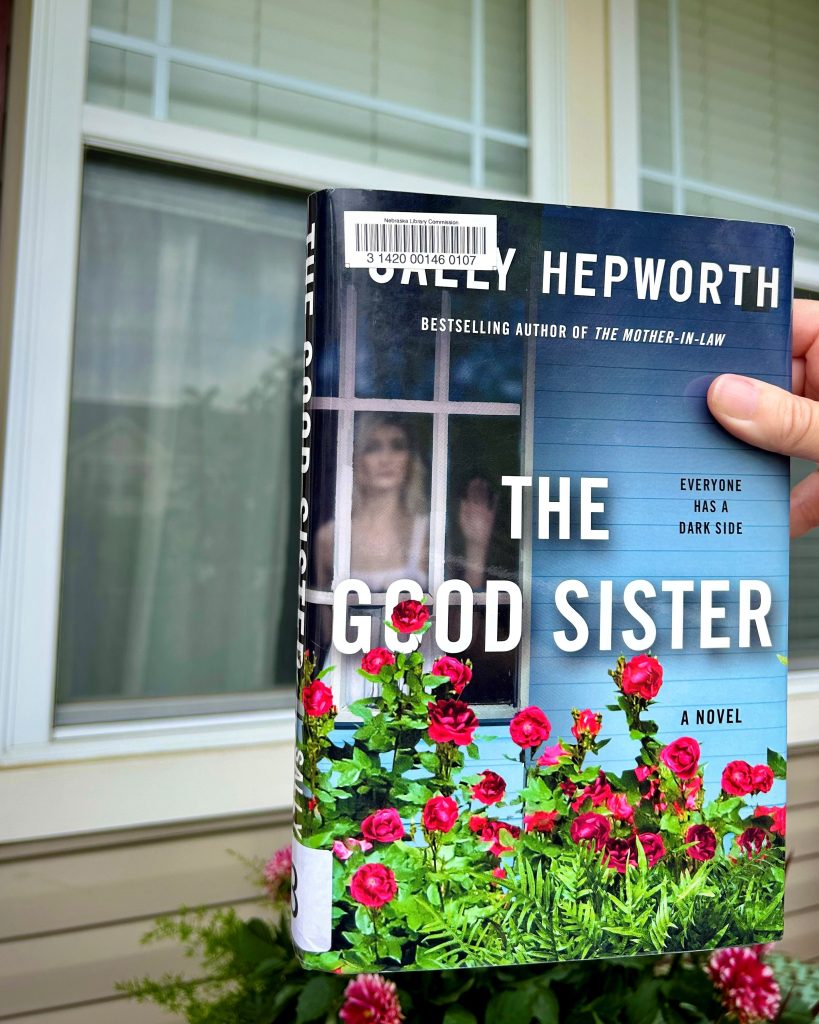
There’s no sibling rivalry with this week’s #BookFaceFriday. Read all about it in “The Good Sister” by Sally Hepworth, it’s available for check out from our Book Club Kit Collection.
Your book club won’t be able to put down this psychological thriller about two sisters and devastating family secrets. Put it on your TBR list today and request this kit for your book club.“Hepworth’s latest further solidifies her place among the top domestic suspense authors…Fern is drawn as smart, capable, and probably on the spectrum, and she is multilayered and relatable, illustrating Hepworth’s talent for page-turners with depth.”
—Booklist
Book Club Kits Rules for Use
- These kits can be checked out by the librarians of Nebraska libraries and media centers.
- Circulation times are flexible and will be based upon availability. There is no standard check-out time for book club kits.
- Please search the collection to select items you wish to borrow and use the REQUEST THIS KIT icon to borrow items.
- Contact the Information Desk at the Library Commission if you have any questions: by phone: 800/307-2665, or by email: Information Services Team
This title is also available as both an eBook and Audiobook through Nebraska OverDrive Libraries. You can find seven other titles by Sally Hepworth in the OverDrive collection! Libraries participating in the Nebraska OverDrive Libraries Group currently have access to a shared and growing collection of digital downloadable audiobooks and eBooks. 194 libraries across the state share the Nebraska OverDrive collection of 26,898 audiobooks, 36,794 ebooks, and 5,133 magazines. As an added bonus it includes 130 podcasts that are always available with simultaneous use (SU), as well as SU ebooks and audiobook titles that publishers have made available for a limited time. If you’re a part of it, let your users know about this great title, and if you’re not a member yet, find more information about participating in Nebraska Overdrive Libraries!
Love this #BookFace & reading? Check out our past #BookFaceFriday photos on the Nebraska Library Commission’s Facebook page!
#BookFaceFriday “Long Way Down” by Jason Reynolds
This #BookFaceFriday will really push your buttons!
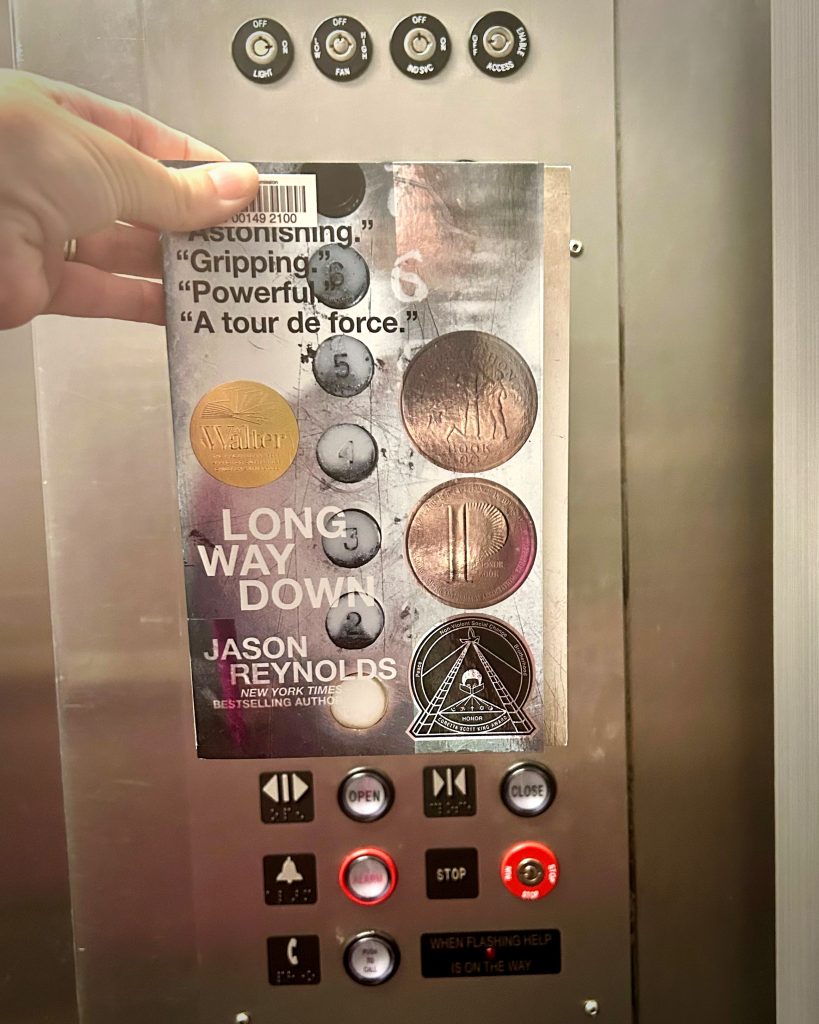
This week’s #BookFace, “Long Way Down” by New York Times bestselling author Jason Reynolds, is a Newbery Honor Book and a Coretta Scott King Honor Book.
This electric YA novel is available as a part of our Book Club Kit collection, along with five other books written by Jason Reynolds.“Spanning a mere one minute and seven seconds, Reynolds’ new free-verse novel is an intense snapshot of the chain reaction caused by pulling a trigger. Reynolds’ concise verses echo like shots against the white space of the page, their impact resounding. He peels back the individual stories that led to this moment in the elevator and exposes a culture inured to violence because poverty, gang life, or injustice has left them with no other option. In this all too real portrait of survival, Reynolds goes toe-to-toe with where, or even if, love and choice are allowed to exist.”
—Booklist, starred review
Book Club Kits Rules for Use
- These kits can be checked out by the librarians of Nebraska libraries and media centers.
- Circulation times are flexible and will be based upon availability. There is no standard check-out time for book club kits.
- Please search the collection to select items you wish to borrow and use the REQUEST THIS KIT icon to borrow items.
- Contact the Information Desk at the Library Commission if you have any questions: by phone: 800/307-2665, or by email: Information Services Team
This title is also available as an Audiobook through Nebraska OverDrive Libraries. You can find ten other books by Jason Reynolds in our Kids and Teens collection! Libraries participating in the Nebraska OverDrive Libraries Group currently have access to a shared and growing collection of digital downloadable audiobooks and eBooks. 194 libraries across the state share the Nebraska OverDrive collection of 26,898 audiobooks, 36,794 ebooks, and 5,133 magazines. As an added bonus it includes 130 podcasts that are always available with simultaneous use (SU), as well as SU ebooks and audiobook titles that publishers have made available for a limited time. If you’re a part of it, let your users know about this great title, and if you’re not a member yet, find more information about participating in Nebraska Overdrive Libraries!
Love this #BookFace & reading? Check out our past #BookFaceFriday photos on the Nebraska Library Commission’s Facebook page!
#BookFaceFriday “Miss Morissa” by Mari Sandoz
We’ve struck gold this #BookFaceFriday!
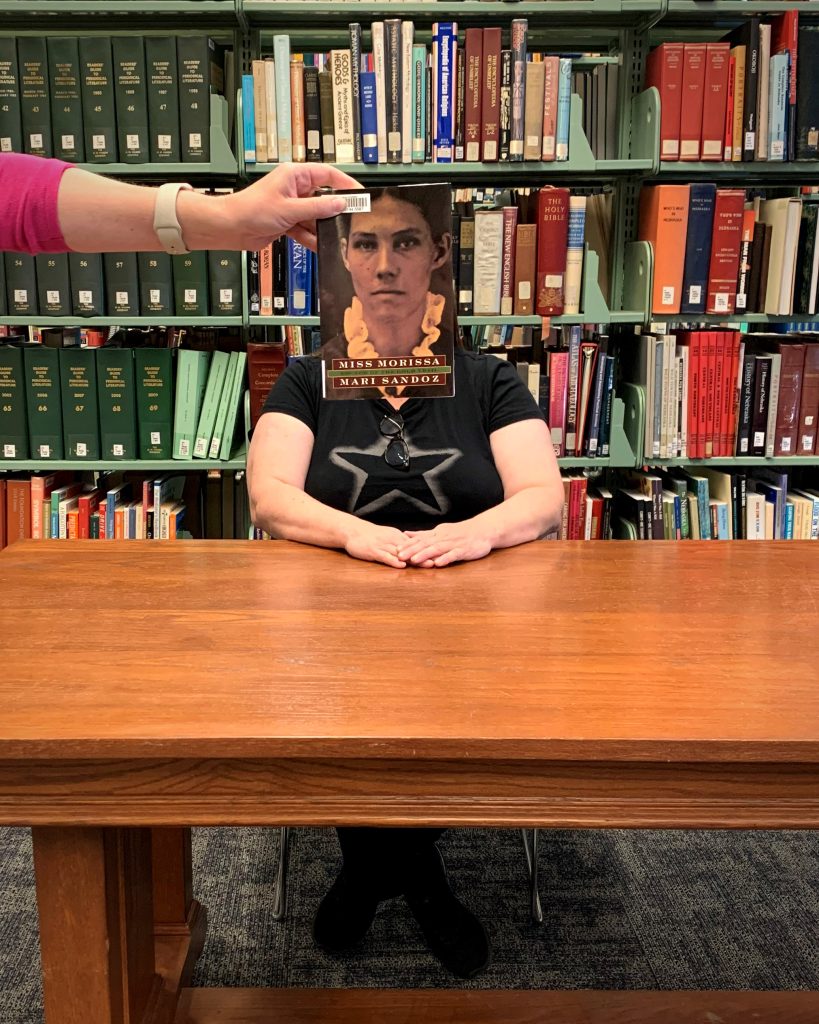
This week’s #BookFace is “Miss Morissa: Doctor of the Gold Trail” by Nebraskan author Mari Sandoz; it tells the story of a young pioneering woman doctor on the Nebraska frontier in the 1870’s as rumors of gold strikes begin to spread. This dramatic and moving historical fiction novel is available as a part of our Book Club Kit collection, along with eight other books written by Mari Sandoz.
“Beautifully written and full of striking images and masterful descriptions.”
—New York Times
This week’s model is model is our brand-new Computer Help Desk Support, Kim Ramsey! Kim recently transferred to the Library Commission from Nebraska Dept. of Health and Human Services. She reached 25 years of state employment in May and most of that time has been providing computer and technical support to state employees and other agencies. Kim lives in Lincoln with her husband Mike, and their two cats, Mei and Juno, who are their entertainment and sometimes their alarm clock. Science fiction is her favorite genre and she is currently re-reading “The Expanse” series by authors Daniel Abraham and Ty Franck. Gardening and reading are her stress relief, and garden/plant talk is probably the best way to distract her from whatever she’s supposed to be doing. If you get the chance, say hello to Kim!
Book Club Kits Rules for Use
- These kits can be checked out by the librarians of Nebraska libraries and media centers.
- Circulation times are flexible and will be based upon availability. There is no standard check-out time for book club kits.
- Please search the collection to select items you wish to borrow and use the REQUEST THIS KIT icon to borrow items.
- Contact the Information Desk at the Library Commission if you have any questions: by phone: 800/307-2665, or by email: Information Services Team
While we don’t have this particular title available through Nebraska OverDrive Libraries, we do have a significant number of the author’s other works available. You can find eleven books by Mari Sandoz, including the 2007 One Book One Nebraska selection “Crazy Horse” on Nebraska Overdrive! Libraries participating in the Nebraska OverDrive Libraries Group currently have access to a shared and growing collection of digital downloadable audiobooks and eBooks. 194 libraries across the state share the Nebraska OverDrive collection of 26,898 audiobooks, 36,794 ebooks, and 5,133 magazines. As an added bonus it includes 130 podcasts that are always available with simultaneous use (SU), as well as SU ebooks and audiobook titles that publishers have made available for a limited time. If you’re a part of it, let your users know about this great title, and if you’re not a member yet, find more information about participating in Nebraska Overdrive Libraries!
Love this #BookFace & reading? Check out our past #BookFaceFriday photos on the Nebraska Library Commission’s Facebook page!
Posted in Books & Reading, General
Tagged book club kit, Book Covers, bookfacefriday, Historical Fiction, libraries, Mari Sandoz, Miss Morissa, Nebraska Author, Reading
Leave a comment
Friday Reads & BookFace Friday: “Making It So” by Patrick Stewart
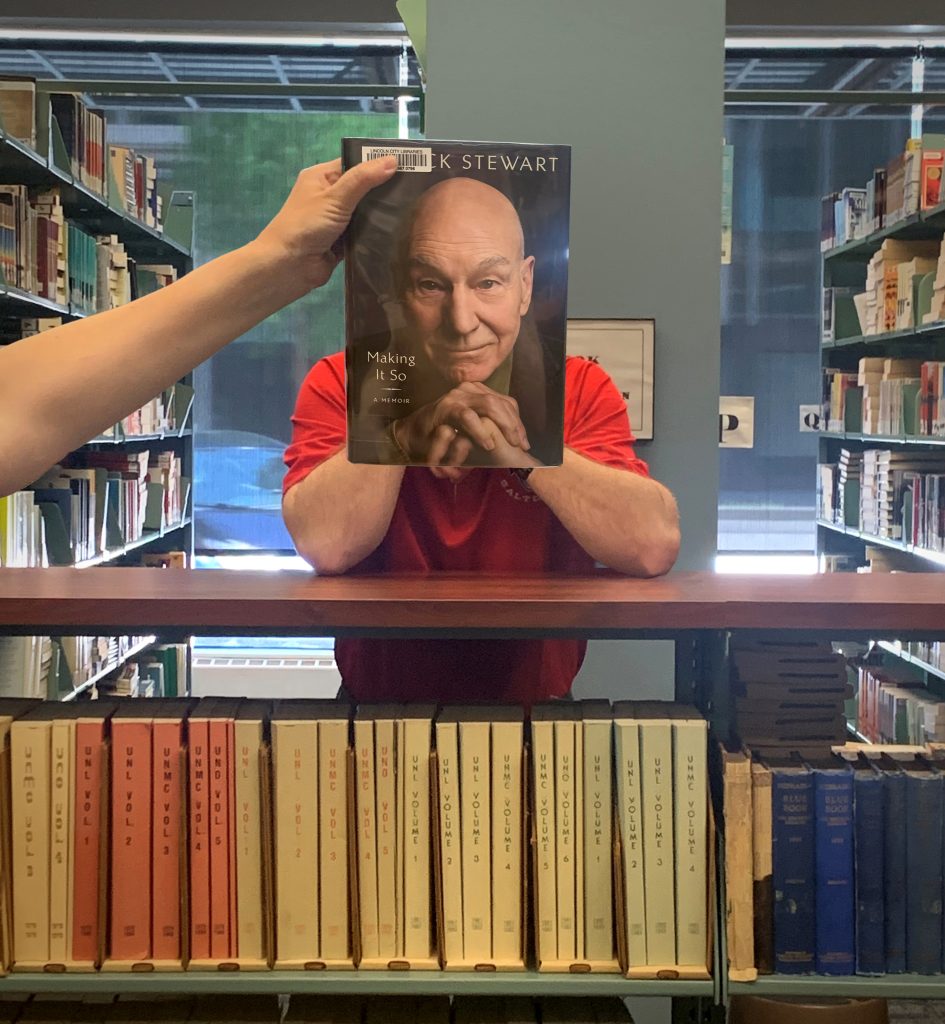
I remember watching and enjoying Star Trek: The Next Generation, starring Patrick Stewart as Jean-Luc Picard, but I wouldn’t call myself a diehard Trekkie. That was no barrier to finding Making It So, Stewart’s recently released memoir, enchanting and delightful. Especially the Audie award-winning audio edition, narrated by Stewart, himself.
As you can imagine, he declaims every word of every sentence with gusto!Stewart (b. 1940) starts at the beginning, describing what it was like growing up working class in Yorkshire in the 1940s and early 1950s. This includes a brief etymology lesson on the Yorkshire dialect he grew up speaking, which, according to Stewart, would have been “nearly incomprehensible to Londoners, let alone Americans.” For instance, he explains that “ata,” which meant “are you,” descended from “art though”; “nowt” meant “nothing”; “Geroff!” meant “leave me alone”; and a chamber pot was a “gazunder,” because it “goes under” the bed. This is relevant since in order to become an actor he had to learn “received pronunciation,” or “RP.” (RP was the standard pronunciation used by BBC broadcasters back in the day.)
Stewart also does a good job conveying the degree to which theater permeated English society at the time. It ranged from amateur dramatics (“am-drams”) at the local level, to a network of regional repertory theaters, all the way up to the Royal Shakespeare Company in Stratford-upon-Avon and the National Theatre in London. And thanks to financial support by the government in the form of grants and scholarships, it was accessible to all—even a working-class boy like Stewart, who got his start locally and then worked his way to the top.
If you are particularly interested in the Star Trek: Next Generation portion of this memoir, you’ll have to be patient, or skip to chapter 16. From there on out (there are a total of 25 chapters in the book), you will be rewarded with lots of insider, behind-the-scenes information about Stewart’s time as Picard. There are also plenty of details about his stint as Charles Xavier in the X-Men movie franchise, and voice work for Seth MacFarlane’s Family Guy and American Dad, as well as other television, film, theater, and social media projects he’s participated in, including reciting all Shakespeare’s sonnets on Instagram during the pandemic lockdown.
While this memoir will appeal to Trekkies, theater nerds, and Anglofiles, there are also elements that will resonate with anyone who has lived a long life filled with both gratitude and regret. In later chapters, Stewart expresses remorse over the demise of his 23-year marriage to his first wife, and the damage that did to his relationship with their children, Daniel and Sophie: “[T]he hurt caused by my split with their mother has never fully gone away,” he writes. After a second brief marriage falls apart, he laments: “And so, another divorce. I felt stupid and responsible.” But he also joyfully expounds on life with his third wife, Sunny Ozell, to whom he’s been married since 2013, as well as his well-publicized friendship with Ian McKellen. Overall, Stewart comes across as a vibrant, engaged octogenarian who, despite living a full, rich life, is still ready for more!
Stewart, Patrick. Making It So: A Memoir. Gallery Books, 2023.
You can find “Making It So: A Memoir” by Patrick Stewart as an eBook in Nebraska OverDrive Libraries! Libraries participating in the Nebraska OverDrive Libraries Group currently have access to a shared and growing collection of digital downloadable audiobooks and eBooks. 194 libraries across the state share the Nebraska OverDrive collection of 26,174 audiobooks, 36,611 ebooks, and 5,210 magazines. As an added bonus it includes 130 podcasts that are always available with simultaneous use (SU), as well as SU ebooks and audiobook titles that publishers have made available for a limited time. If you’re a part of it, let your users know about this great title, and if you’re not a member yet, find more information about participating in Nebraska Overdrive Libraries!
Love this #BookFace & Friday Reads? We suggest checking out all the titles available in our Book Club collection, permanent collection, and Nebraska OverDrive Libraries. Check out our past #BookFaceFriday photos on the Nebraska Library Commission’s Facebook page!
Posted in Books & Reading, General
Tagged Book Covers, bookface, bookfacefriday, Ebook, Friday Reads, Making It So, Memoir, Nebraska OverDrive Libraries, Patrick Stewart, Reading
Leave a comment

































